Temporal and Spatial Variations of Energy Exchanging Under Varying Urban Riparian Forest Plant Communities: A Case Study of Shanghai, China
Abstract
1. Introduction
2. Materials and Methods
2.1. Study Sites
2.2. Plant Material
2.3. Field Data Collection
2.4. Derivation of Sensible Heat Flux (H) and Latent Heat Fluxes (LE)
2.5. Statistical Analysis
2.6. Data Quality Control and Analysis
3. Results
3.1. Temporal Variations of Environmental Parameters
3.2. Spatial Distribution of Environmental Parameters
3.3. Temporal Variations of H and LE
3.4. Spatial Distributions of H and LE
3.5. Machine-Learning-Based Attribution of Heat-Flux Variability
4. Discussion
4.1. Discussion of Daily-Scale Drivers in Riparian Grassland and Forests
4.2. Discussion of Annual-Scale Drivers in Riparian Grassland and Forests
4.3. Limitations
5. Conclusions
Author Contributions
Funding
Data Availability Statement
Acknowledgments
Conflicts of Interest
Abbreviations
| H | sensible heat flux |
| LE | latent heat fluxes |
| LAI | leaf area index |
| CC | canopy closure |
| CP | canopy porosity |
| Ts | soil temperature |
| SWC | soil water content |
| VPD | water pressure deficit |
| u | wind speed |
| Rn | net radiation |
| PAR | photosynthetically active radiation |
| SUN | sunshine duration |
| TH | tree height |
| CH | canopy height |
| CW | canopy width |
| VL | vertical layering |
| SOM | soil organic matter |
Appendix A
| Heat Fluxes | Month | CCO· | CMO | CCH | CUO | CMH | CUH |
|---|---|---|---|---|---|---|---|
| CC | 1 | 59.70 | 61.20 | 58.90 | 65.50 | 65.90 | 62.90 |
| 2 | 55.60 | 65.40 | 65.40 | 62.60 | 67.10 | 65.80 | |
| 3 | 50.10 | 66.02 | 62.84 | 65.28 | 69.95 | 61.28 | |
| 4 | 52.30 | 61.90 | 54.20 | 50.40 | 63.40 | 47.80 | |
| 5 | 54.45 | 43.02 | 26.00 | 53.01 | 51.47 | 28.52 | |
| 6 | 53.20 | 40.70 | 49.80 | 48.50 | 53.70 | 30.56 | |
| 7 | 54.45 | 41.96 | 53.01 | 26.00 | 51.47 | 28.52 | |
| 8 | 67.82 | 49.06 | 51.46 | 53.53 | 67.83 | 41.16 | |
| 9 | 53.75 | 56.10 | 57.07 | 63.47 | 73.20 | 64.77 | |
| 10 | 57.30 | 59.60 | 59.10 | 65.80 | 75.80 | 63.90 | |
| 11 | 64.60 | 64.80 | 60.50 | 69.40 | 73.70 | 65.60 | |
| 12 | 65.84 | 67.13 | 63.71 | 63.52 | 69.25 | 67.15 | |
| LAI | 1 | 1.68 | 2.32 | 2.04 | 2.05 | 2.64 | 2.67 |
| 2 | 1.65 | 2.29 | 1.64 | 1.80 | 1.61 | 1.49 | |
| 3 | 1.64 | 2.36 | 1.53 | 1.41 | 1.21 | 1.23 | |
| 4 | 1.75 | 1.54 | 1.67 | 1.13 | 1.03 | 0.80 | |
| 5 | 1.86 | 0.79 | 1.24 | 0.50 | 0.79 | 0.50 | |
| 6 | 1.35 | 0.86 | 1.09 | 0.57 | 1.04 | 0.53 | |
| 7 | 0.95 | 1.14 | 1.03 | 0.66 | 1.10 | 0.51 | |
| 8 | 1.52 | 1.67 | 1.12 | 0.99 | 2.08 | 1.19 | |
| 9 | 1.77 | 2.00 | 1.53 | 1.57 | 3.55 | 1.51 | |
| 10 | 1.58 | 2.87 | 1.69 | 1.91 | 3.64 | 1.84 | |
| 11 | 1.81 | 3.11 | 1.83 | 2.23 | 3.82 | 2.49 | |
| 12 | 1.69 | 3.22 | 2.10 | 2.45 | 3.95 | 2.49 | |
| CP | 1 | 10.53 | 15.38 | 21.84 | 9.38 | 18.49 | 17.47 |
| 2 | 11.36 | 15.92 | 23.52 | 8.47 | 17.30 | 19.43 | |
| 3 | 9.01 | 13.90 | 21.33 | 6.10 | 10.38 | 20.13 | |
| 4 | 10.87 | 19.06 | 25.74 | 10.56 | 20.54 | 26.50 | |
| 5 | 10.37 | 30.54 | 23.05 | 18.98 | 43.61 | 39.14 | |
| 6 | 10.56 | 30.86 | 29.54 | 22.03 | 42.73 | 40.30 | |
| 7 | 10.37 | 30.54 | 26.18 | 23.05 | 43.61 | 39.14 | |
| 8 | 21.18 | 28.88 | 43.57 | 18.30 | 28.18 | 31.53 | |
| 9 | 10.50 | 20.56 | 15.37 | 12.06 | 15.49 | 9.90 | |
| 10 | 10.93 | 14.47 | 19.28 | 14.63 | 13.20 | 15.92 | |
| 11 | 9.45 | 16.72 | 18.45 | 12.95 | 16.71 | 14.31 | |
| 12 | 10.17 | 15.59 | 20.27 | 10.54 | 18.73 | 22.35 |
| Parameter/Site | CCO· | CMO | CH | CCH | CUO | CMH | CUH | |
|---|---|---|---|---|---|---|---|---|
| PAR | / | / | 10.95 | / | / | 4.30 | / | |
| Net radiation | / | / | 11.12 | / | / | 4.30 | / | |
| Sunshine duration | / | / | / | / | / | / | 8.22 | |
| Air temperature | 1 m-to-river | 1.10 | 8.22 | 1.08 | 4.93 | 6.85 | 3.01 | 2.19 |
| 6 m-to-river | 4.66 | 0.55 | 2.74 | 5.48 | 5.48 | 1.37 | 3.29 | |
| 11 m-to-river | 9.86 | 2.74 | 4.93 | 5.75 | 0.82 | 5.75 | 2.10 | |
| Air relative humidity | 1 m-to-river | 1.10 | 8.22 | 1.08 | 4.93 | 6.85 | 3.01 | 2.19 |
| 6 m-to-river | 4.66 | 0.55 | 2.74 | 5.48 | 5.48 | 1.37 | 3.29 | |
| 11 m-to-river | 9.86 | 2.74 | 4.93 | 5.75 | 0.82 | 5.75 | 2.10 | |
| Wind speed | 1 m-to-river | 1.10 | 8.22 | 1.08 | 4.93 | 6.85 | 2.47 | 2.19 |
| 6 m-to-river | 4.66 | 1.09 | 2.47 | 1.10 | 1.10 | 0.55 | 3.29 | |
| 11 m-to-river | 6.85 | 1.92 | 4.93 | 0.55 | 0.82 | 6.03 | 2.15 | |
| Soil temperature | 1 m-to-river | / | 0.55 | 4.11 | / | 6.85 | 6.58 | 11.16 |
| 6 m-to-river | 8.49 | 0.55 | 4.11 | / | 5.48 | 0.82 | / | |
| 11 m-to-river | 8.22 | 10.96 | 0.27 | 0.82 | 0.55 | / | 4.11 | |
| Soil water content | 1 m-to-river | / | 0.55 | 4.11 | / | 6.85 | 7.67 | 8.49 |
| 6 m-to-river | 8.49 | 6.85 | 4.11 | / | 2.74 | 1.10 | / | |
| 11 m-to-river | 8.22 | 10.96 | 13.67 | 7.95 | 0.55 | 0.27 | 4.11 | |
| Heat Flux | Temporal Scales | Riparian Sites | Model | R2 | RMSE | MAE |
|---|---|---|---|---|---|---|
| H | Daily | Grassland | Random Forest | 0.953 | 5.393 | 3.222 |
| XGBoost | 0.949 | 5.639 | 3.240 | |||
| MLP | 0.938 | 6.223 | 4.022 | |||
| SVR | 0.907 | 7.625 | 4.340 | |||
| LightGBM | 0.888 | 8.363 | 4.944 | |||
| Forests | Random Forest | 0.651 | 14.526 | 6.091 | ||
| XGBoost | 0.603 | 16.831 | 7.671 | |||
| LightGBM | 0.595 | 17.251 | 8.960 | |||
| MLP | 0.581 | 23.874 | 9.118 | |||
| SVR | 0.501 | 26.292 | 13.808 | |||
| Annual | Grassland | Random Forest | 0.764 | 10.355 | 6.236 | |
| LightGBM | 0.719 | 11.395 | 6.166 | |||
| SVR | 0.717 | 11.397 | 6.130 | |||
| MLP | 0.595 | 16.505 | 13.308 | |||
| XGBoost | 0.264 | 16.792 | 13.566 | |||
| Forests | Random Forest | 0.681 | 13.481 | 7.711 | ||
| MLP | 0.663 | 13.963 | 8.178 | |||
| LightGBM | 0.658 | 14.111 | 8.002 | |||
| XGBoost | 0.652 | 14.257 | 8.360 | |||
| SVR | 0.639 | 14.602 | 8.659 | |||
| LE | Daily | Grassland | Random Forest | 0.960 | 7.278 | 5.004 |
| XGBoost | 0.946 | 8.498 | 5.666 | |||
| MLP | 0.945 | 8.530 | 5.514 | |||
| SVR | 0.905 | 11.265 | 6.457 | |||
| LightGBM | 0.895 | 11.797 | 6.089 | |||
| Forests | Random Forest | 0.781 | 12.016 | 7.432 | ||
| XGBoost | 0.717 | 16.291 | 7.067 | |||
| LightGBM | 0.692 | 17.863 | 9.929 | |||
| MLP | 0.651 | 22.363 | 11.877 | |||
| SVR | 0.612 | 22.569 | 11.198 | |||
| Annual | Grassland | Random Forest | 0.960 | 7.278 | 5.004 | |
| LightGBM | 0.946 | 8.498 | 5.666 | |||
| SVR | 0.945 | 8.530 | 5.514 | |||
| MLP | 0.905 | 11.265 | 6.457 | |||
| XGBoost | 0.895 | 11.797 | 6.089 | |||
| Forests | Random Forest | 0.776 | 10.274 | 6.563 | ||
| MLP | 0.757 | 10.860 | 6.921 | |||
| LightGBM | 0.756 | 10.901 | 6.987 | |||
| XGBoost | 0.746 | 10.192 | 7.014 | |||
| SVR | 0.726 | 10.776 | 7.333 |
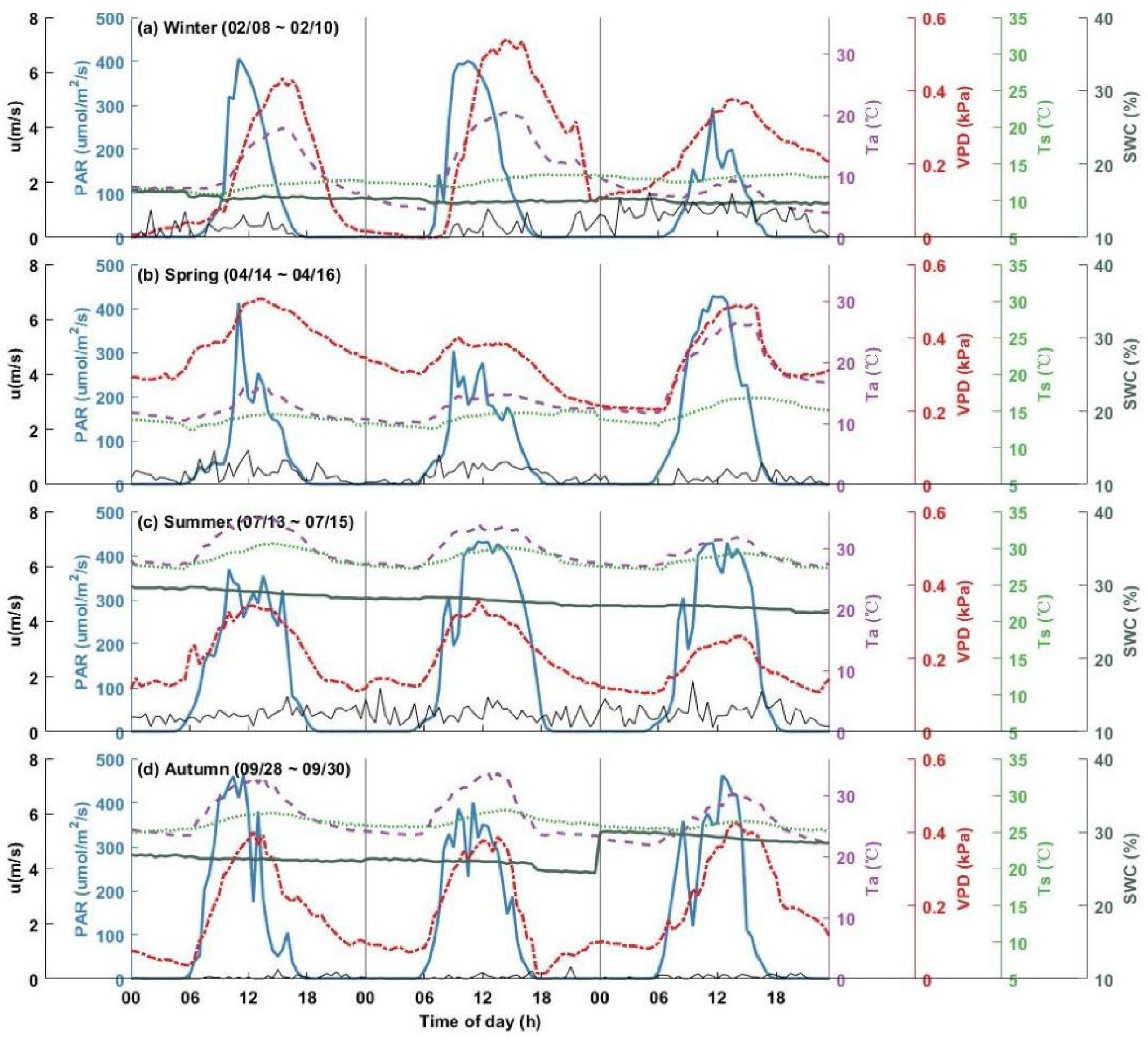
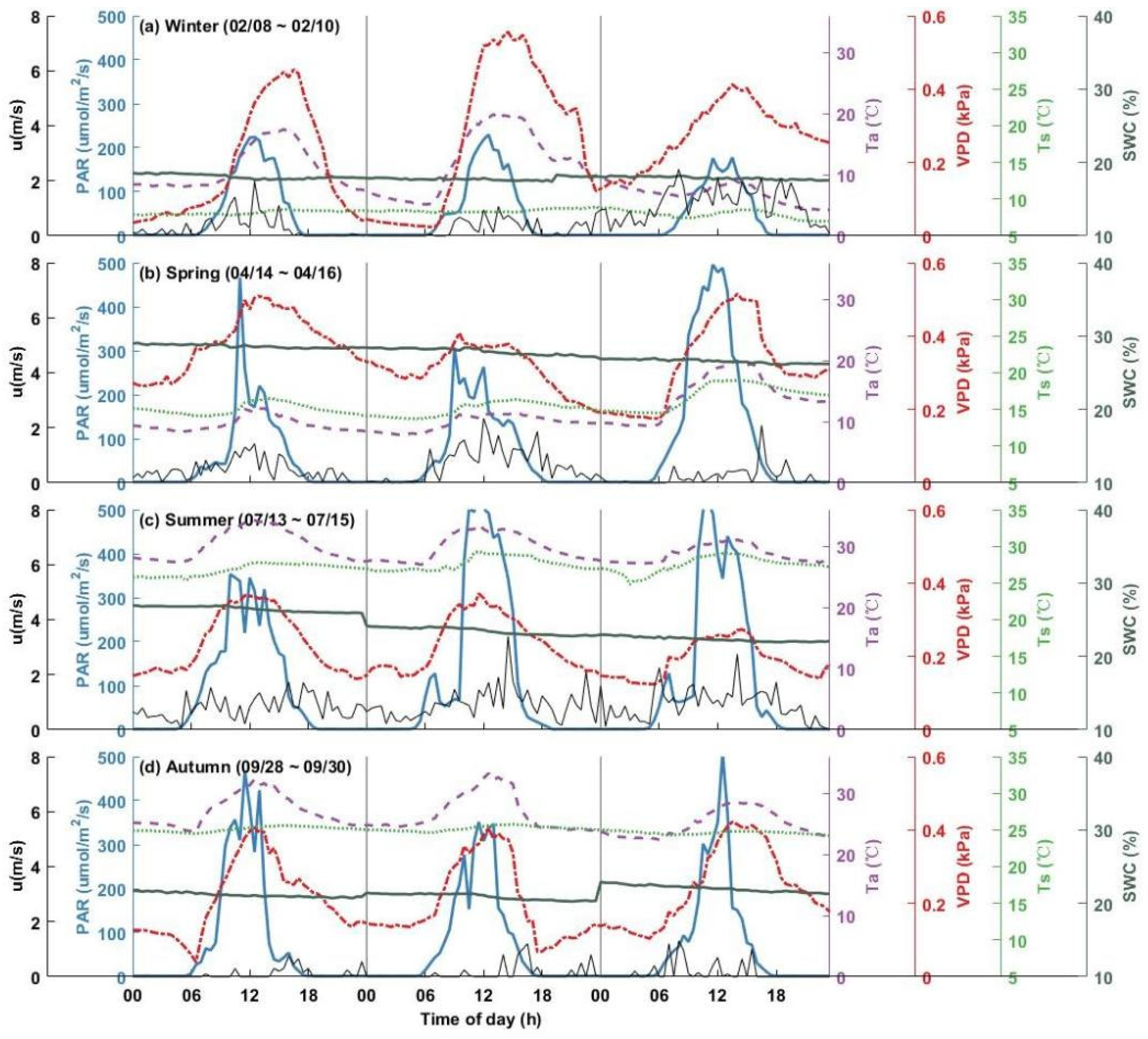
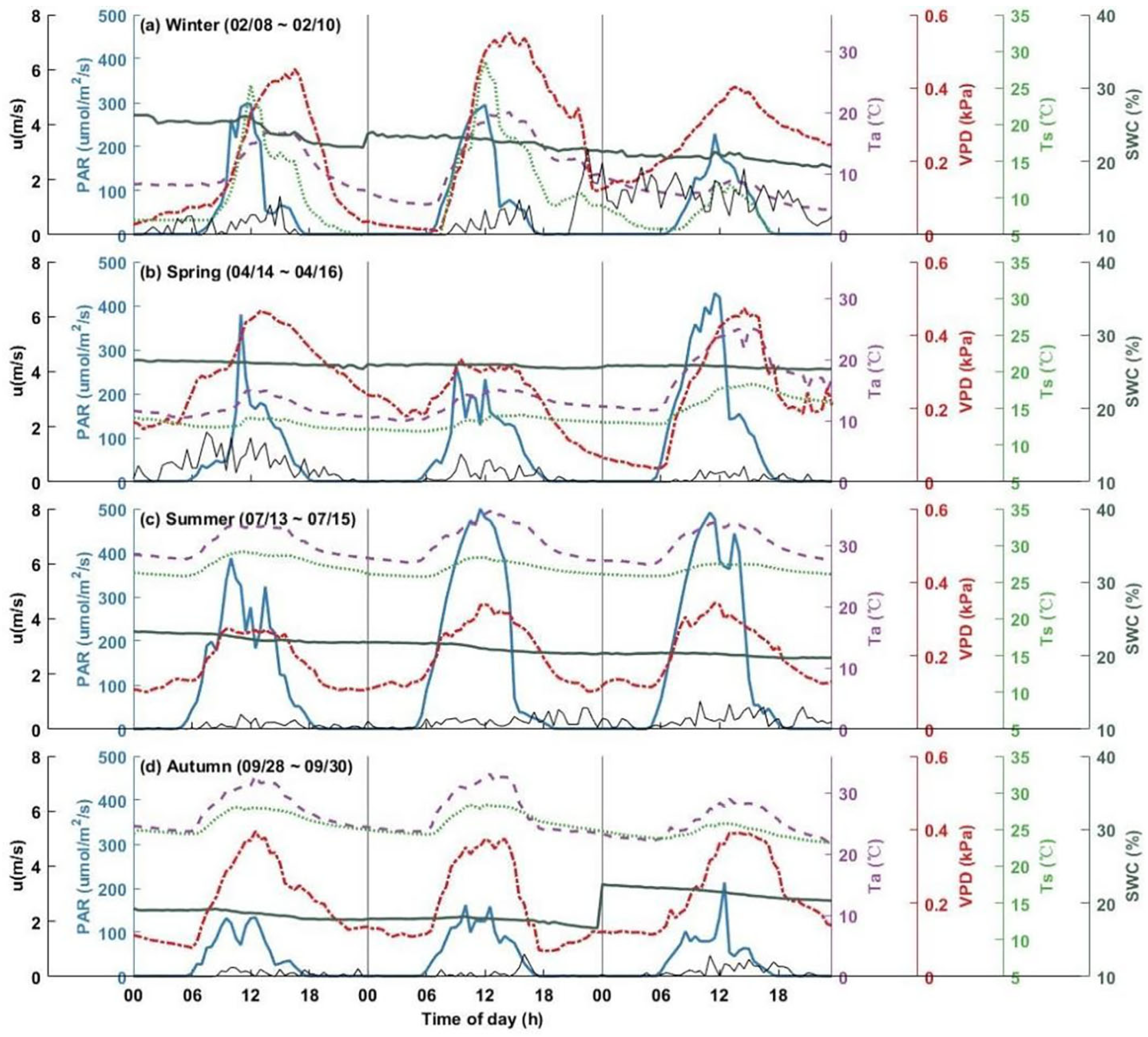
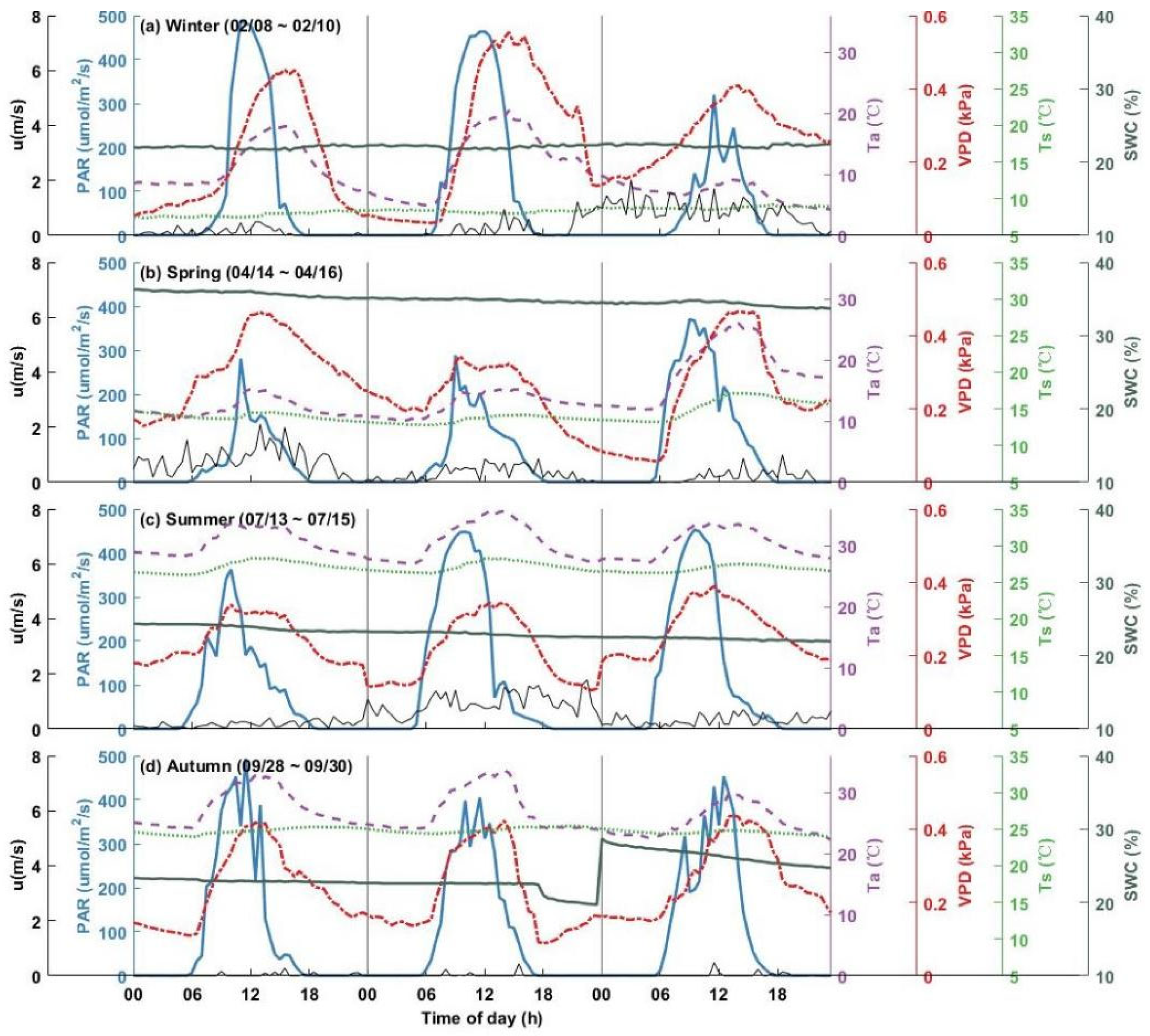

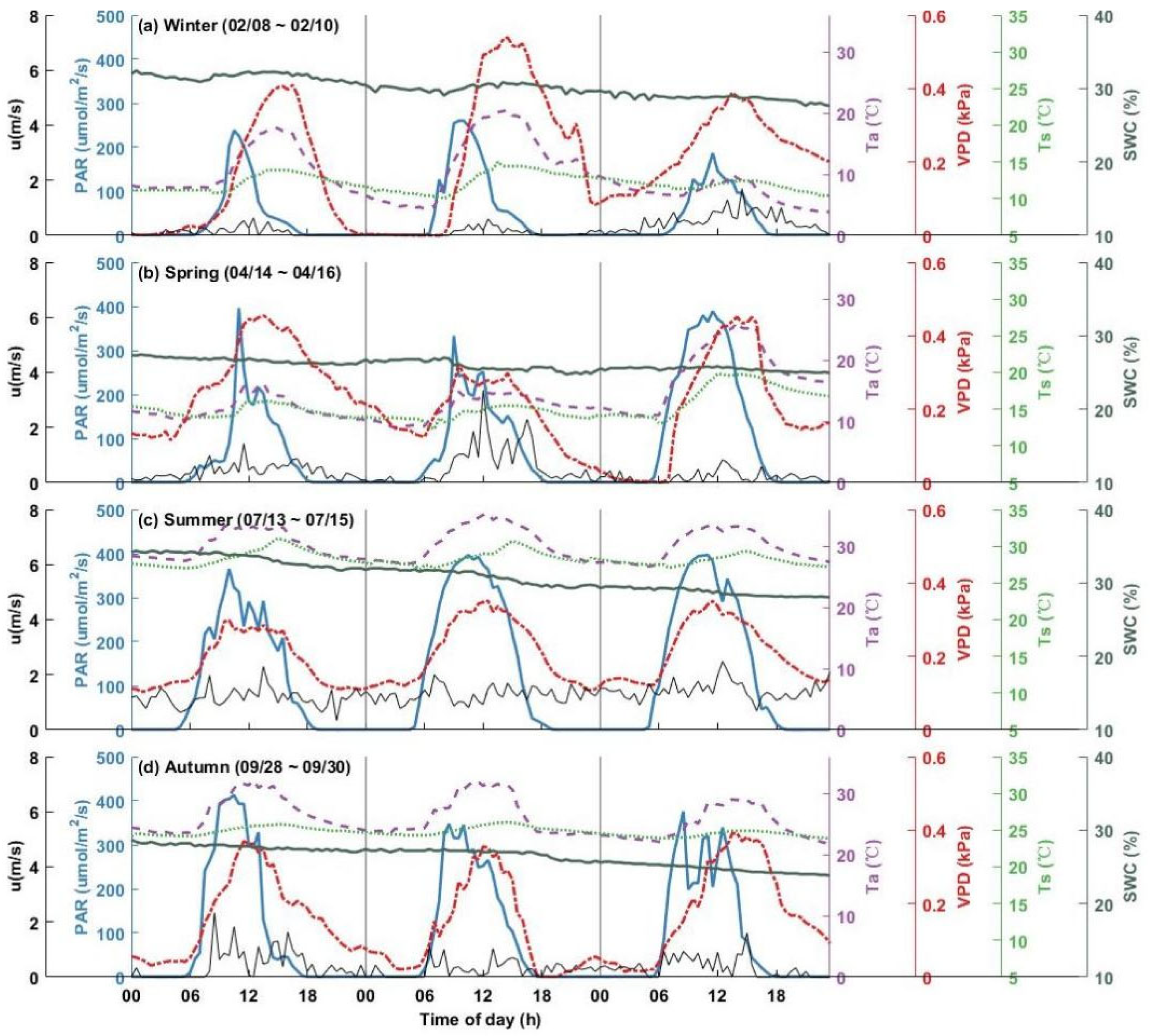


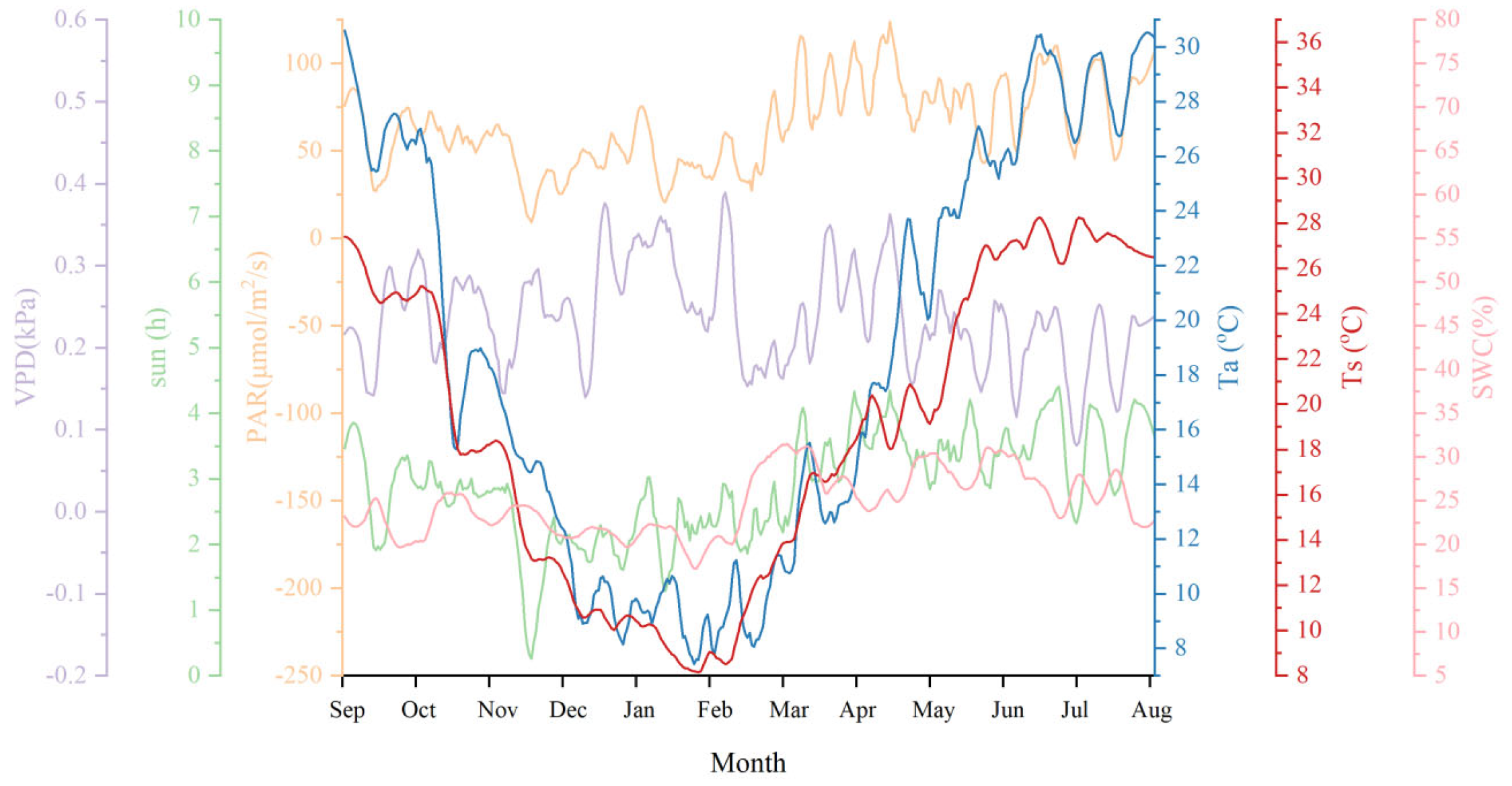
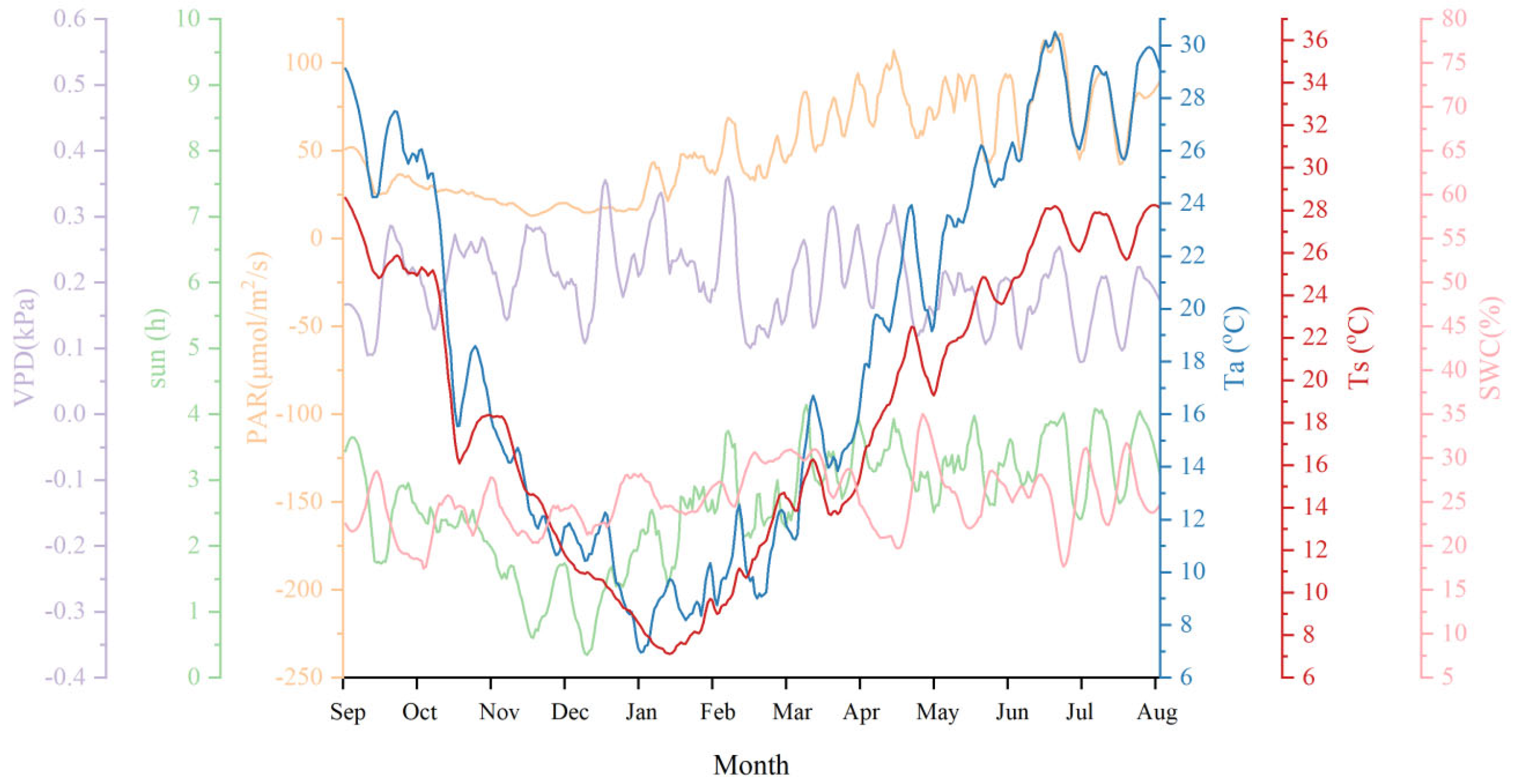
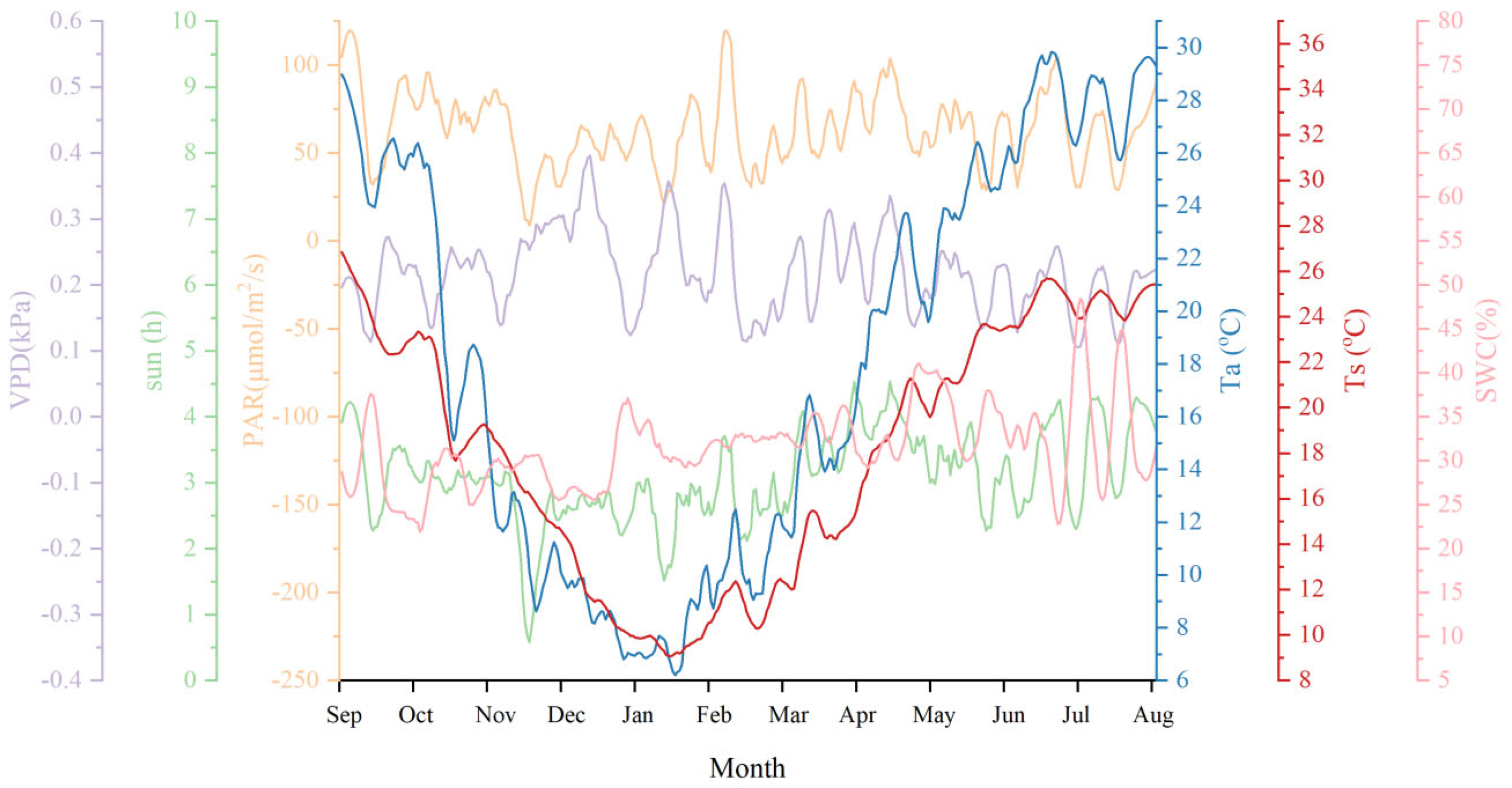
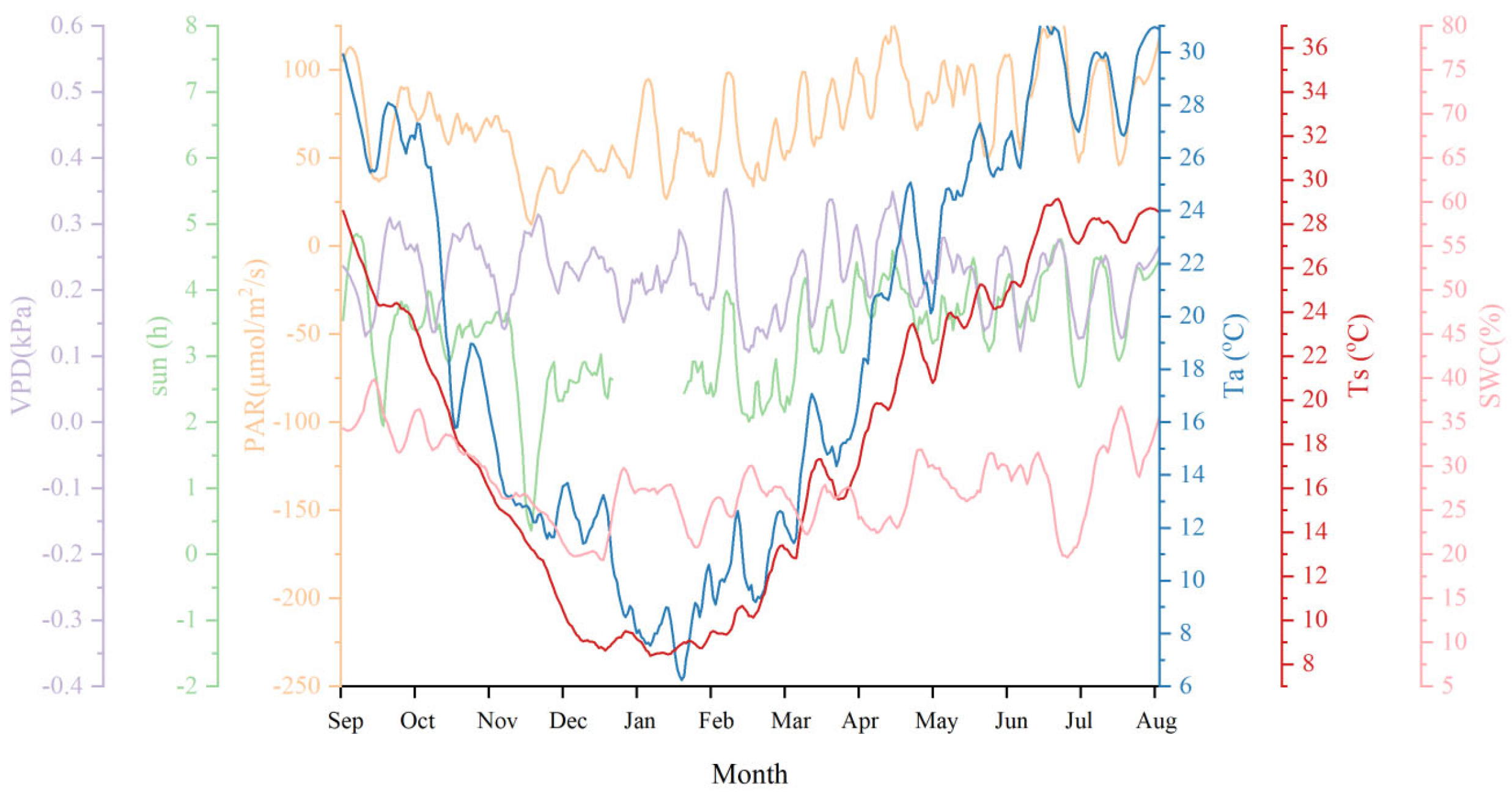
References
- Yu, Z.; Yang, G.; Zuo, S.; Gertrud, J.; Motoya, K.; Henrik, V. Critical review on the cooling effect of urban blue-green space: A threshold-size perspective. Urban For. Urban Green. 2020, 49, 126630. [Google Scholar] [CrossRef]
- Wang, K.; Dickinson, R.E. A review of global terrestrial evapotranspiration: Observation, modeling, climatology, and climatic variability: Global terrestrial evapotranspiration. Rev. Geophys. 2012, 50, RG2005. [Google Scholar] [CrossRef]
- Ballinger, A.; Lake, P.S. Energy and nutrient fluxes from rivers and streams into terrestrial food webs. Mar. Freshw. Res. 2006, 57, 15. [Google Scholar] [CrossRef]
- Oettel, J.; Braun, M.; Sallmannshofer, M.; De Groot, M.; Schueler, S.; Virgillito, C.; Westergren, M.; Božič, G.; Nagy, L.; Stojnić, S.; et al. River distance, stand basal area, and climatic conditions are the main drivers influencing lying deadwood in riparian forests. For. Ecol. Manag. 2022, 520, 520120415. [Google Scholar] [CrossRef]
- Cai, Z.; Han, G.; Chen, M. Do water bodies play an important role in the relationship between urban form and land surface temperature? Sustain. Cities Soc. 2018, 39, 487–498. [Google Scholar] [CrossRef]
- Ballinas, M.; Barradas, V.L. Transpiration and stomatal conductance as potential mechanisms to mitigate the heat load in Mexico City. Urban For. Urban Green. 2016, 20, 152–159. [Google Scholar] [CrossRef]
- Garner, G.; Malcolm, I.A.; Sadler, J.P.; Millar, C.P.; Hannah, D.M. Inter-annual variability in the effects of riparian woodland on micro-climate, energy exchanges and water temperature of an upland Scottish stream. Hydrol. Process. 2015, 29, 1080–1095. [Google Scholar] [CrossRef]
- Salata, F.; Golasi, I.; Petitti, D.; Emanuele de, L.V.; Massimo, C.; Andrea, L.V.d. Relating microclimate, human thermal comfort and health during heat waves: An analysis of heat island mitigation strategies through a case study in an urban outdoor environment. Sustain. Cities Soc. 2017, 30, 79–96. [Google Scholar] [CrossRef]
- Kumagai, T.; Saitoh, T.M.; Sato, Y.; Toshiyuki, M.; Odair, J.M.; Koichiro, K.; Masakazu, S. Transpiration, canopy conductance and the decoupling coefficient of a lowland mixed dipterocarp forest in Sarawak, Borneo: Dry spell effects. J. Hydrol. 2004, 287, 237–251. [Google Scholar] [CrossRef]
- Leuning, R. Estimation of scalar source/sink distributions in plant canopies using lagrangian dispersion analysis: Corrections for atmospheric stability and comparison with a multilayer canopy model. Bound. Layer Meteorol. 2000, 96, 293–314. [Google Scholar] [CrossRef]
- Wang, A. Estimation of water vapor source/sink distribution and evapotranspiration over broadleaved Koreanpine forest in Changbai Mountain using inverse Lagrangian dispersion analysis. Geophys. Res. 2005, 110, D08102. [Google Scholar] [CrossRef]
- Zhang, S.Y.; Li, X.Y.; Ma, Y.J.; Guo, Q.Z.; Liu, L.; Ji, C.; Zhi, Y.J.; Yong, M.H. Interannual and seasonal variability in evapotranspiration and energy partitioning over the alpine riparian shrub Myricaria squamosa Desv. on Qinghai–Tibet Plateau. Cold Reg. Sci. Technol. 2014, 102, 8–20. [Google Scholar] [CrossRef]
- Kan, Y.; Shao, H.; Yao, Y.; Li, Y.; Zhang, X.; Xu, J.; Zhang, X.; Xie, Z.; Ning, J.; Yu, R.; et al. Evaluation of two strategies from the SEBS model for estimating the daily terrestrial evapotranspiration values of the Tibetan Plateau. J. Hydrol. 2025, 656, 132921. [Google Scholar] [CrossRef]
- Mingyue, Z.; Guojie, W.; Hagan, D.F.T.; Waheed, U.; Giri, K.; Jiao, L.; ShiJie, L. Impacts of Vegetation Changes on Land Evapotranspiration in China During 1982–2015. Front. Environ. Sci. 2022, 10, 819277. [Google Scholar] [CrossRef]
- Hu, Z.; Yu, G.; Zhou, Y.; Sun, X.; Li, Y.; Peili, S.; Wang, Y.; Xia, S.; Zemei, Z.; Li, Z.; et al. Partitioning of evapotranspiration and its controls in four grassland ecosystems: Application of a two-source model. Agric. For. Meteorol. 2009, 149, 1410–1420. [Google Scholar] [CrossRef]
- Wang, Q.-W.; Robson, T.M.; Pieristè, M.; Kenta, T.; Zhou, W.; Kurokawa, H. Canopy structure and phenology modulate the impacts of solar radiation on C and N dynamics during litter decomposition in a temperate forest. Sci. Total Environ. 2022, 820, 153185. [Google Scholar] [CrossRef]
- Miri, A.; Dragovich, D.; Dong, Z. The response of live plants to airflow—Implication for reducing erosion. Aeolian Res. 2018, 33, 93–105. [Google Scholar] [CrossRef]
- Ma, W.; Yu, Z.; Chen, J.; Yang, W.; Zhang, Y.; Hu, Y.; Shao, M.; Hu, J.; Zhang, Y.; Zhang, H.; et al. What drives the cooling dynamics of urban vegetation via evapotranspiration and shading under extreme heat? Sustain. Cities Socities 2025, 130, 106659. [Google Scholar] [CrossRef]
- Best, L.; Schwarz, N.; Obergh, D.; Teuling, A.J.; Van Kanten, R.; Willemen, L. Urban green spaces and variation in cooling in the humid tropics: The case of Paramaribo. Urban For. Urban Green. 2023, 89, 128111. [Google Scholar] [CrossRef]
- Alonzo, M.; Ibsen, P.C.; Locke, D.H. Urban Trees and Cooling: A Review of the Recent Literature (2018 to 2024). Arboric. Urban For. 2025, 51, 1–24. [Google Scholar] [CrossRef]
- Zhou, J.; Yang, K.; Crow, W.T.; Dong, J.; Zhao, L.; Feng, H.; Zou, M.; Lu, H.; Tang, R.; Jiang, Y. Potential of remote sensing surface temperature- and evapotranspiration-based land-atmosphere coupling metrics for land surface model calibration. Remote Sens. Environ. 2023, 291, 113557. [Google Scholar] [CrossRef]
- Detommaso, M.; Costanzo, V.; Nocera, F. Application of weather data morphing for calibration of urban ENVI-met microclimate models. Results and critical issues. Urban Clim. 2021, 38, 100895. [Google Scholar] [CrossRef]
- Brozovsky, J.; Simonsen, A.; Gaitani, N. Validation of a CFD model for the evaluation of urban microclimate at high latitudes: A case study in Trondheim, Norway. Build. Environ. 2021, 205, 108175. [Google Scholar] [CrossRef]
- Schöneberger, P.; Sinsel, T.; Ouyang, W.; Tan, Z.; Bruse, M.; Simon, H. Enhancing urban microclimate simulations: Validating ENVI-met’s accuracy in modeling multi-directional radiative fluxes and mean radiant temperature in subtropical hong kong. Build. Environ. 2025, 284, 113475. [Google Scholar] [CrossRef]
- Yu, Z.; Chen, J.; Chen, J.; Zhan, W.; Wang, C.; Ma, W.; Yao, X.; Zhou, S.; Zhu, K.; Sun, R. Enhanced observations from an optimized soil-canopy-photosynthesis and energy flux model revealed evapotranspiration-shading cooling dynamics of urban vegetation during extreme heat. Remote Sens. Environ. 2025, 305, 114098. [Google Scholar] [CrossRef]
- Zhang, Q.; Jia, B.; Li, T.; Yang, Y.; Fang, Y. Dynamic changes and drives of surface urban heat islands in China. City Environ. Interact. 2025, 27, 100203. [Google Scholar] [CrossRef]
- Liang, A.; Xie, C.; Wang, J.; Che, S. Daily Dynamics of Soil Heat Flux and Its Relationship with Net Radiation in Different Urban Riparian Woodlands. Forests 2022, 13, 2062. [Google Scholar] [CrossRef]
- Dong, J.; Wu, L.; Zeng, W.; Xiao, X.; He, J. Analysis of spatial-temporal trends and causes of vapor pressure deficit in China from 1961 to 2020. Atmos. Res. 2024, 299, 107199. [Google Scholar] [CrossRef]
- Guenther, S.M.; Moore, R.D.; Gomi, T. Riparian microclimate and evaporation from a coastal headwater stream, and their response to partial-retention forest harvesting. Agric. For. Meteorol. 2012, 164, 1–9. [Google Scholar] [CrossRef]
- Ma, N.; Zhang, Y.; Guo, Y.; Gao, H.; Zhang, H.; Wang, Y. Environmental and biophysical controls on the evapotranspiration over the highest alpine steppe. J. Hydrol. 2015, 529, 980–992. [Google Scholar] [CrossRef]
- Ma, J.; Zha, T.; Jia, X.; Tian, Y.; Bourque, C.P.; Bourque, C.P.; Liu, P.; Bai, Y.; Wu, Y.; Ren, C.L.; et al. Energy and water vapor exchange over a young plantation in northern China. Agric. For. Meteorol. 2018, 263, 334–345. [Google Scholar] [CrossRef]
- Sommer, R.; Sá TDde, A.; Vielhauer, K.; de Araújo, A.C.; Fölster, H.; Vlek, P.L. Transpiration and canopy conductance of secondary vegetation in the eastern Amazon. Agric. For. Meteorol. 2002, 112, 103–121. [Google Scholar] [CrossRef]
- Matsumoto, K.; Ohta, T.; Tanaka, T. Dependence of stomatal conductance on leaf chlorophyll concentration and meteorological variables. Agric. For. Meteorol. 2005, 132, 44–57. [Google Scholar] [CrossRef]
- Brenner, A.J.; Incoll, L.D. The effect of clumping and stomatal response on evaporation from sparsely vegetated shrublands. Agric. For. Meteorol. 1997, 84, 187–205. [Google Scholar] [CrossRef]
- Dupont, S.; Patton, E.G. Influence of stability and seasonal canopy changes on micrometeorology within and above an orchard canopy: The CHATS experiment. Agric. For. Meteorol. 2012, 157, 11–29. [Google Scholar] [CrossRef]
- Liu, X.; Yang, S.; Xu, J.; Zhang, J.; Liu, J. Effects of soil heat storage and phase shift correction on energy balance closure of paddy fields. Atmósfera 2017, 30, 39–52. [Google Scholar] [CrossRef]
- Azevedo, B.F.; Rocha, A.M.A.C.; Pereira, A.I. Hybrid approaches to optimization and machine learning methods: A systematic literature review. Mach. Learn. 2024, 113, 4055–4097. [Google Scholar] [CrossRef]
- Shi, D.; Song, J.; Huang, J.; Zhuang, C.; Guo, R.; Gao, Y. Synergistic cooling effects (SCEs) of urban green-blue spaces on local thermal environment: A case study in Chongqing, China. Sustain. Cities Soc. 2020, 55, 102065. [Google Scholar] [CrossRef]
- Hathway, E.A.; Sharples, S. The interaction of rivers and urban form in mitigating the Urban Heat Island effect: A UK case study. Build. Environ. 2012, 58, 14–22. [Google Scholar] [CrossRef]
- Linscheid, N.; Estupinan-Suarez, L.M.; Brenning, A.; Carvalhais, N.; Cremer, F.; Gans, F.; Rammig, A.; Reichstein, M.; Sierra, C.A.; Mahecha, M.D. Towards a global understanding of vegetation–climate dynamics at multiple timescales. Biogeosciences 2020, 17, 945–962. [Google Scholar] [CrossRef]
- Behera, S.K.; Mishra, A.K.; Sahu, N.; Kumar, A.; Singh, N.; Kumar, A.; Bajpai, O.; Chaudhary, L.B.; Khare, P.B.; Tuli, R. The study of microclimate in response to different plant community association in tropical moist deciduous forest from northern India. Biodivers. Conserv. 2012, 21, 1159–1176. [Google Scholar] [CrossRef]
- Liu, H.; Zhang, Q.; Dowler, G. Environmental controls on the surface energy budget over a large southern inland water in the United States: An analysis of one-year eddy covariance flux data. J. Hydrometeorol. 2012, 13, 1893–1910. [Google Scholar] [CrossRef]
- Yu, Z.; Chen, T.; Yang, G.; Sun, R.; Xie, W.; Vejre, H. Quantifying seasonal and diurnal contributions of urban landscapes to heat energy dynamics. Appl. Energy 2020, 264, 114724. [Google Scholar] [CrossRef]
- Gao, Z.; Lenschow, D.H.; He, Z.; Zhou, M.; Wang, L.Y.; Wang, Y.H.; He, J. Seasonal and diurnal variations in moisture, heat and CO2 fluxes over a typical steppe prairie in Inner Mongolia, China. Hydrol. Earth Syst. Sci. 2009, 6, 987–998. [Google Scholar] [CrossRef]
- Zhao, X.; Liu, Y. Phase transition of surface energy exchange in China’s largest freshwater lake. Agric. For. Meteorol. 2017, 244, 98–110. [Google Scholar] [CrossRef]
- Lenters, J.D.; Cutrell, G.J.; Istanbulluoglu, E.; Scott, D.T.; Herrman, K.S.; Irmak, A.; Eisenhauer, D.E. Seasonal energy and water balance of a Phragmites australis-dominated wetland in the Republican River basin of south-central Nebraska (USA). J. Hydrol. 2011, 408, 19–34. [Google Scholar] [CrossRef]
- Wang, L.; Gao, Z.; Pan, Z.; Guo, X.; Bou-Zeid, E. Evaluation of Turbulent Surface Flux Parameterizations over Tall Grass in a Beijing Suburb. J. Hydrometeorol. 2013, 14, 1620–1635. [Google Scholar] [CrossRef]
- Wang, Y.; You, C.; Tan, X.; Ren, T.; Su, T.; Han, X.; Chen, S. Co-regulation of climate and vegetation on seasonal and interannual variations of energy exchange over a temperate grassland. Agric. For. Meteorol. 2025, 369, 110556. [Google Scholar] [CrossRef]
- Zhou, L.T.; Huang, R. Regional differences in surface sensible and latent heat fluxes in China. Theor. Appl. Climatol. 2014, 116, 625–637. [Google Scholar] [CrossRef]
- Xu, C.; Huang, Q.; Haase, D.; Dong, Q.; Teng, Y.; Su, M.; Yang, Z. Cooling Effect of Green Spaces on Urban Heat Island in a Chinese Megacity: Increasing Coverage versus Optimizing Spatial Distribution. Environ. Sci. Technol. 2024, 58, 5811–5820. [Google Scholar] [CrossRef]
- Yuan, G.; Zhang, P.; Shao, M.; Luo, Y.; Zhu, X. Energy and water exchanges over a riparian Tamarix spp. stand in the lower Tarim River basin under a hyper-arid climate. Agric. For. Meteorol. 2014, 194, 144–154. [Google Scholar] [CrossRef]
- Kovács, B.; Tinya, F.; Ódor, P. Stand structural drivers of microclimate in mature temperate mixed forests. Agric. For. Meteorol. 2017, 234, 11–21. [Google Scholar] [CrossRef]
- Stephens, C.M.; Lall, U.; Johnson, F.M.; Marshall, L.A. Landscape changes and their hydrologic effects: Interactions and feedbacks across scales. Earth Sci. Rev. 2021, 212, 103466. [Google Scholar] [CrossRef]
- Olson, D.H.; Anderson, P.D.; Frissell, C.A.; Welsh, H.H.; Bradford, D.F. Biodiversity management approaches for stream–riparian areas: Perspectives for Pacific Northwest headwater forests, microclimates, and amphibians. For. Ecol. Manag. 2007, 246, 81–107. [Google Scholar] [CrossRef]
- Welsh, H.H.; Hodgson, G.R.; Karraker, N.E. Influences of the vegetation mosaic on riparian and stream environments in a mixed forest-grassland landscape in “Mediterranean” northwestern California. Ecography 2005, 28, 537–551. [Google Scholar] [CrossRef]
- Rambo, T.; North, M. Spatial and temporal variability of canopy microclimate in a Sierra Nevada riparian forest. Northwest Sci. 2008, 82, 259–268. [Google Scholar] [CrossRef]
- Lin, P.-A.; Chen, Y.; Ponce, G.; Acevedo, F.E.; Lynch, J.P.; Anderson, C.T.; Ali, J.G.; Felton, G.W. Stomata-mediated interactions between plants, herbivores, and the environment. Trends Plant Sci. 2022, 27, 287–300. [Google Scholar] [CrossRef]
- Su, W.; Charlock, T.P.; Rose, F.G.; Rutan, D. Photosynthetically active radiation from Clouds and the Earth’s Radiant Energy System (CERES) products. J. Geophys. Res. 2007, 112, G02022. [Google Scholar] [CrossRef]
- Chen, S.; Wei, W.; Tong, B.; Chen, L. Effects of soil moisture and vapor pressure deficit on canopy transpiration for two coniferous forests in the Loess Plateau of China. Agric. For. Meteorol. 2023, 339, 109581. [Google Scholar] [CrossRef]
- Wang, X.; Wang, P.; Zhu, Q. Spatio-temporal variation of water and heat fluxes over complex hilly topography in upper reaches of Lijiang river. Trans. Chin. Soc. Agric. Eng. 2012, 28, 118–122. [Google Scholar]
- Parker, G.G.; Harmon, M.E.; Lefsky, M.A.; Chen, J.; Pelt, R.V.; Weis, S.B.; Thomas, S.C.; Winner, W.E.; Shaw, D.C.; Frankling, J.F. Three-dimensional Structure of an Old-growth Pseudotsuga-Tsuga Canopy and Its Implications for Radiation Balance, Microclimate, and Gas Exchange. Ecosystems 2004, 7, 440–453. [Google Scholar] [CrossRef]
- Friedrich, K.; Mlders, N.; Tetzlaff, G. On the Influence of Surface Heterogeneity on the Bowen-Ratio: A Theoretical Case Study. Theor. Appl. Climatol. 2000, 65, 181–196. [Google Scholar] [CrossRef]
- Liu, X.; Feng, Y.; Hu, T.; Luo, Y.; Zhao, X.; Wu, J.; Maeda, E.E.; Ju, W.; Liu, L.; Guo, Q.; et al. Enhancing ecosystem productivity and stability with increasing canopy structural complexity in global forests. Sci. Adv. 2024, 10, 14. [Google Scholar] [CrossRef] [PubMed]
- Liu, Z.; Zhao, B.; Yan, H.; Su, J. Energy Partitioning and Latent Heat Flux Driving Factors of the CAM Plant Pineapple (Ananas comosus (L.) Merril) Grown South Subtropical China. Plants 2024, 13, 21. [Google Scholar] [CrossRef]
- Scott, R.; Edwards, E.A.; Shuttleworth, W.; Huxman, T.E.; Watts, C.J.; Goodrich, D. Interannual and seasonal variation in fluxes of water and carbon dioxide from a riparian woodland ecosystem. Agric. For. Meteorol. 2004, 122, 65–84. [Google Scholar] [CrossRef]
- Beringer, J.; Chapin, F.S.; Thompson, C.C.; Mcguire, A.D. Surface energy exchanges along a tundra-forest transition and feedbacks to climate. Agric. For. Meteorol. 2005, 131, 143–161. [Google Scholar] [CrossRef]
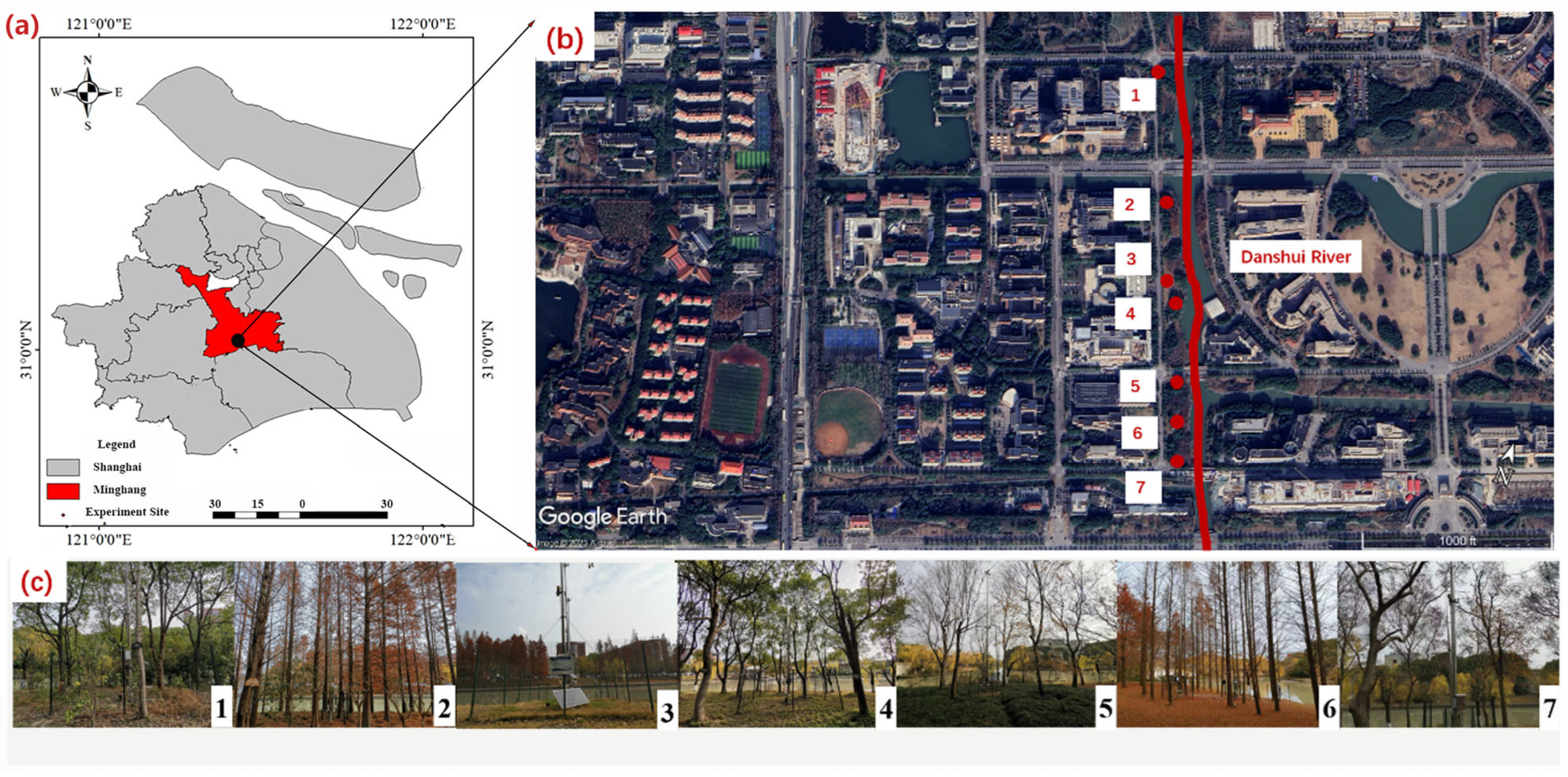
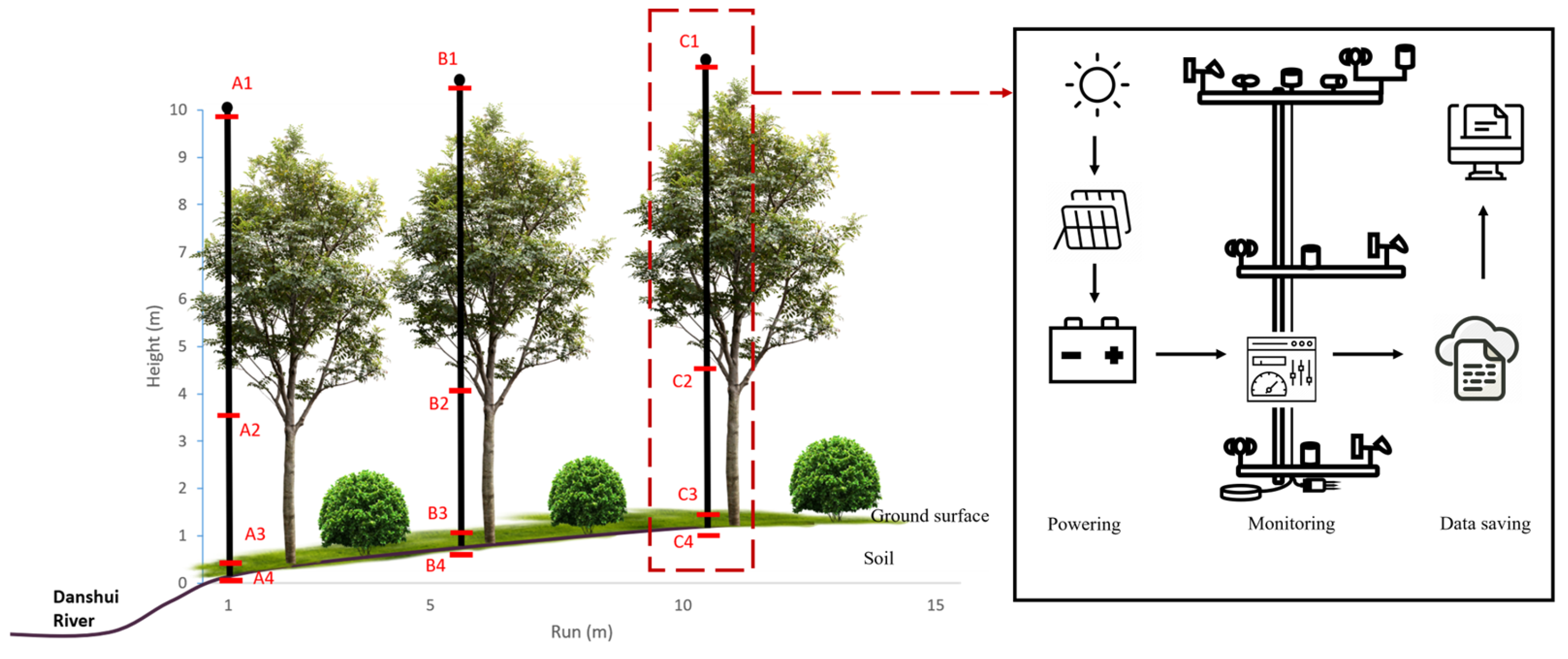
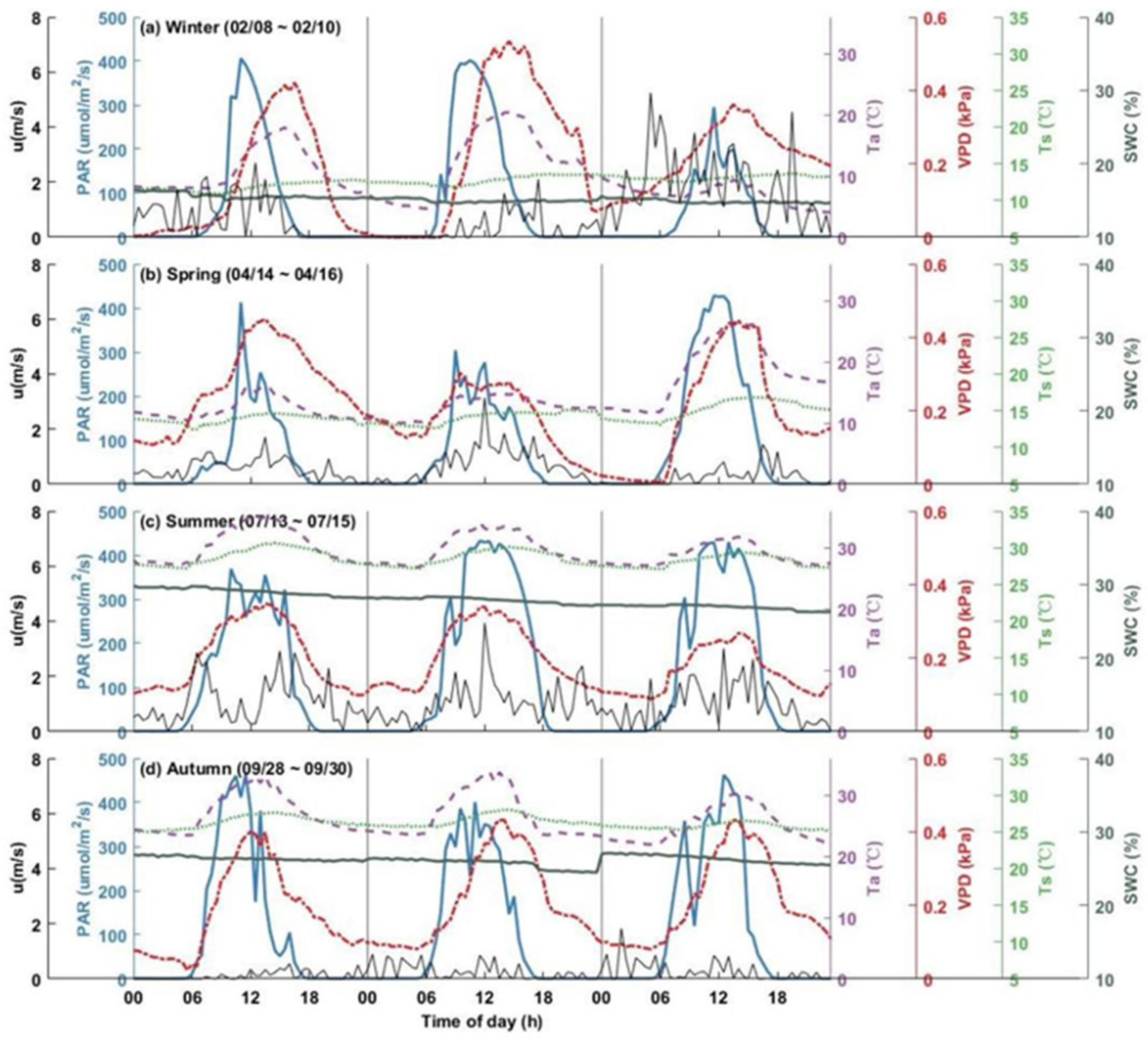
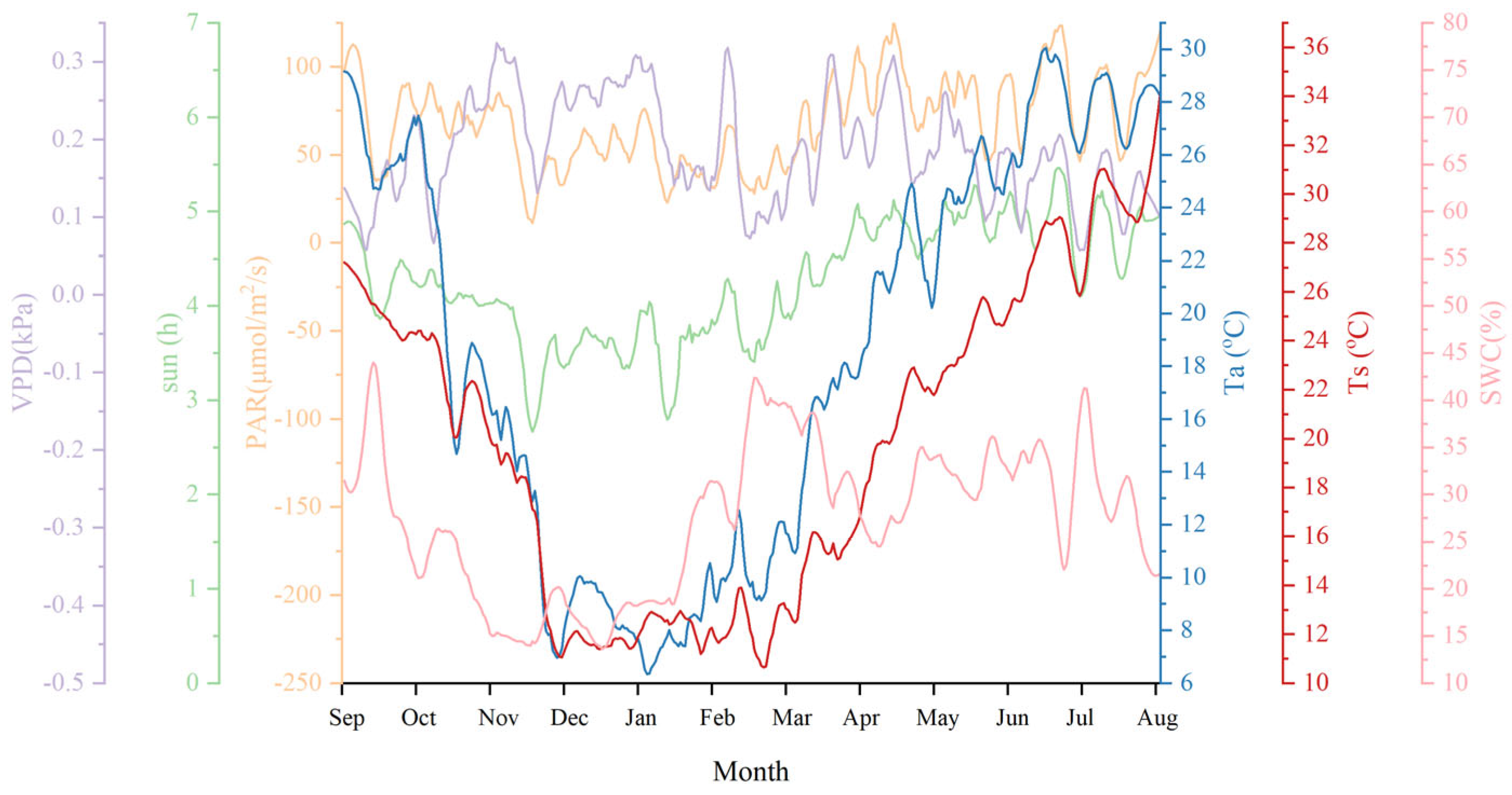
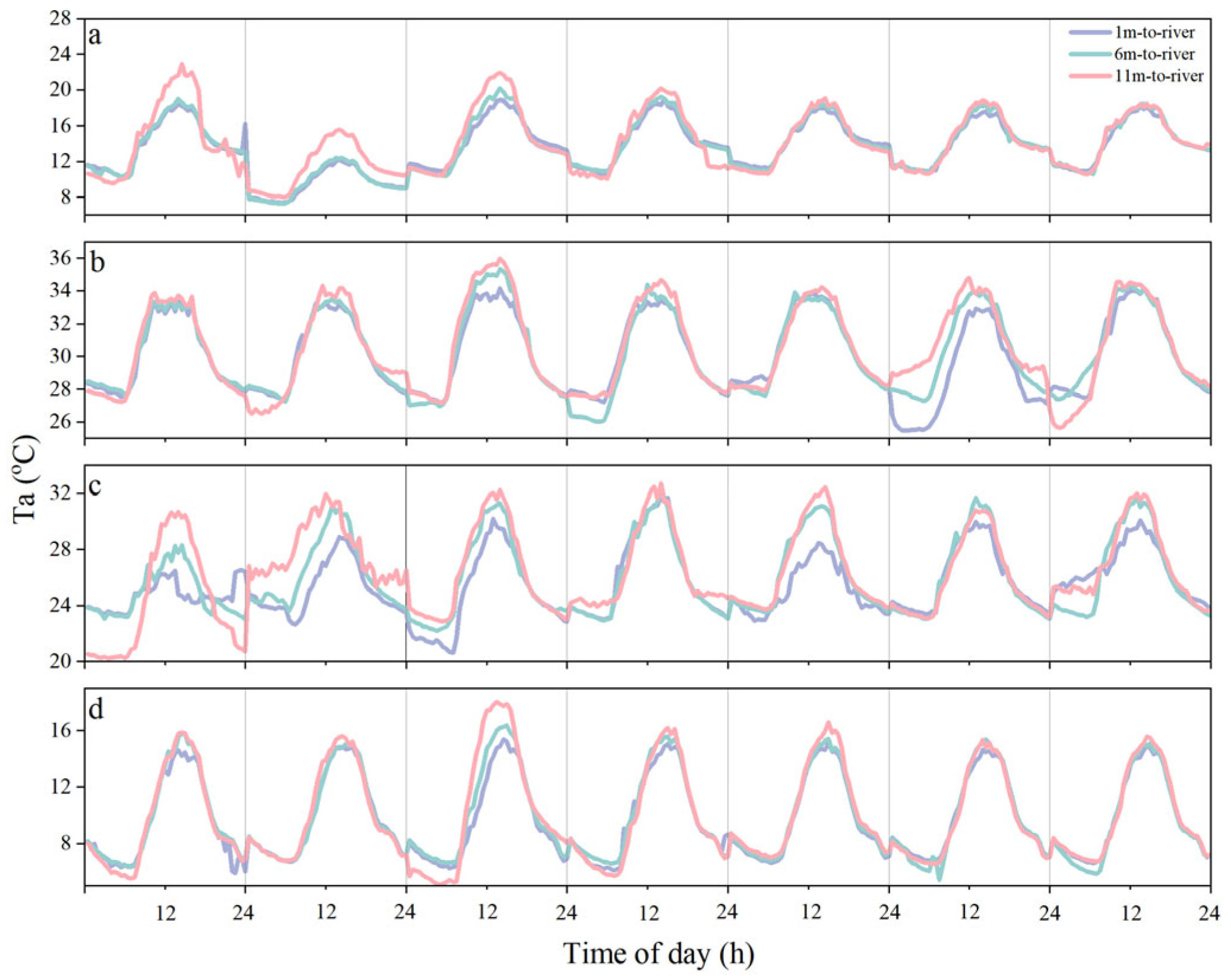

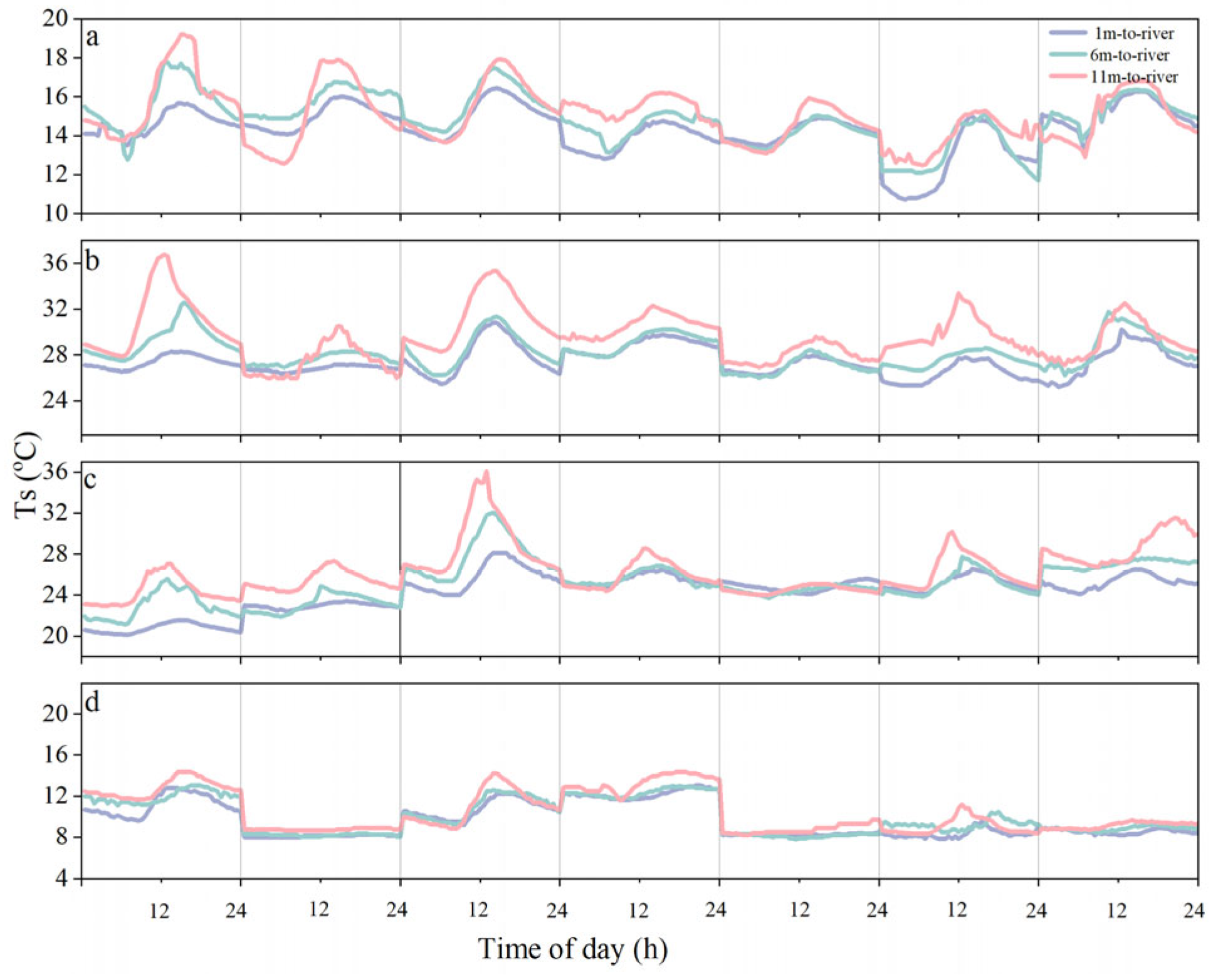
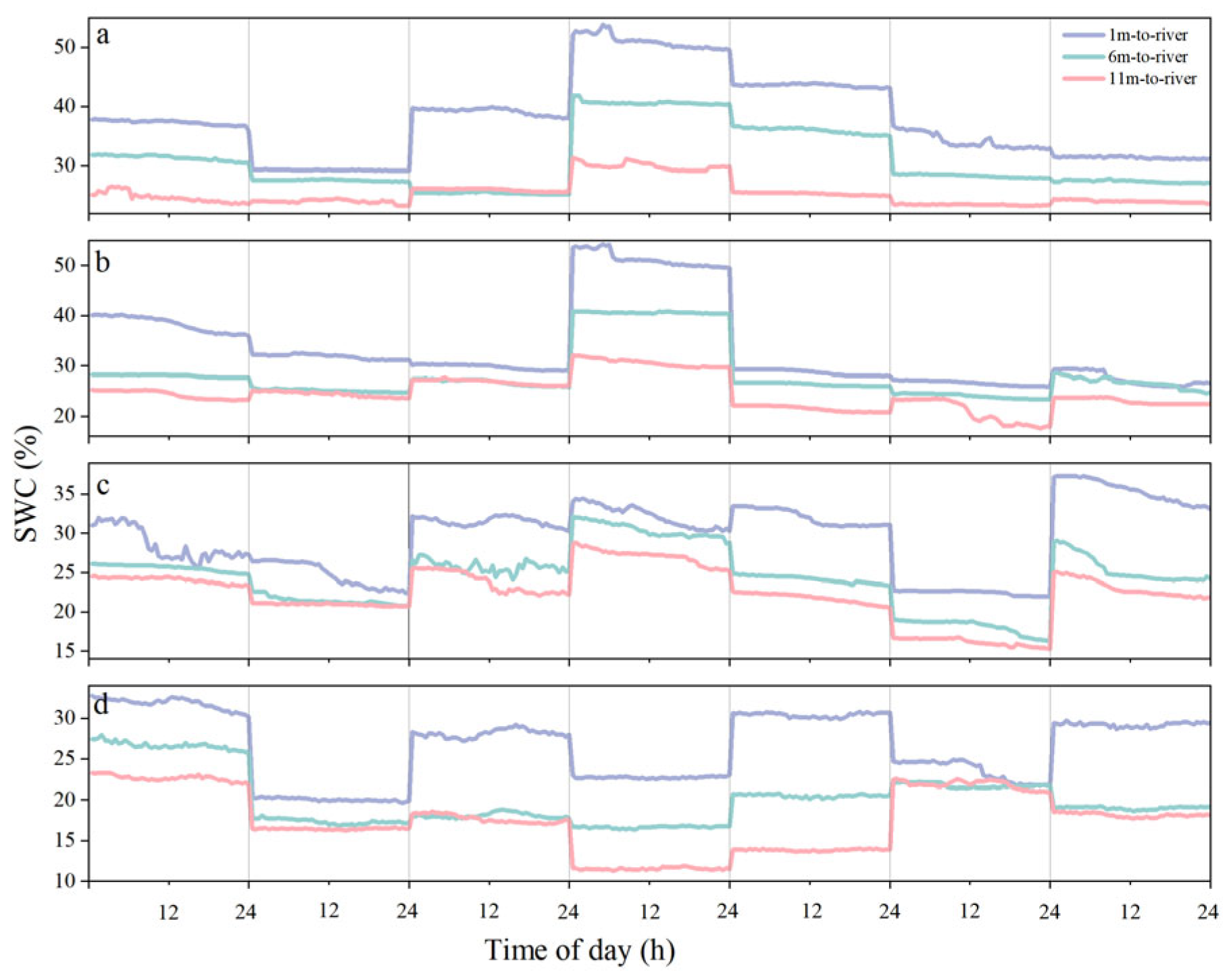

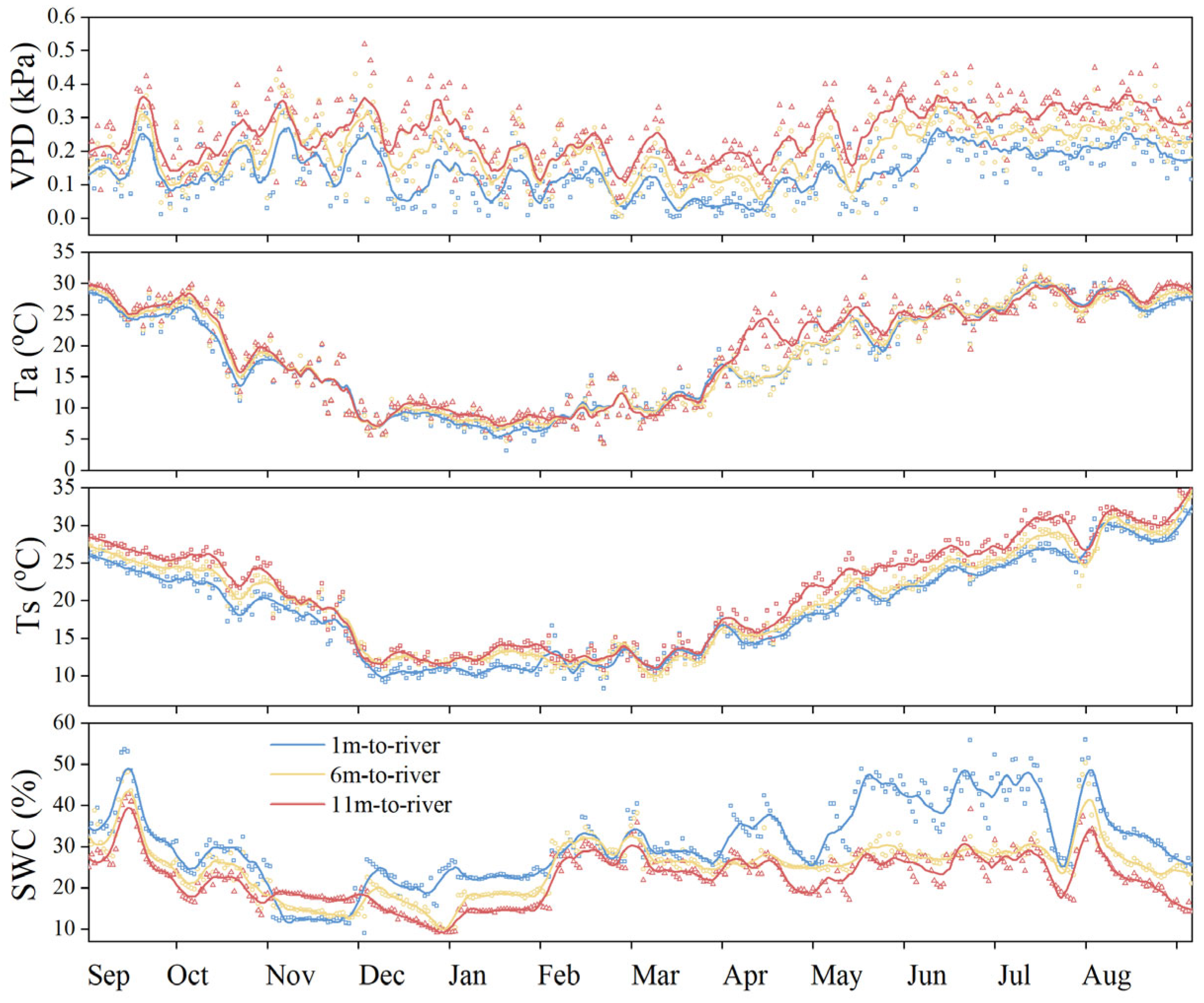
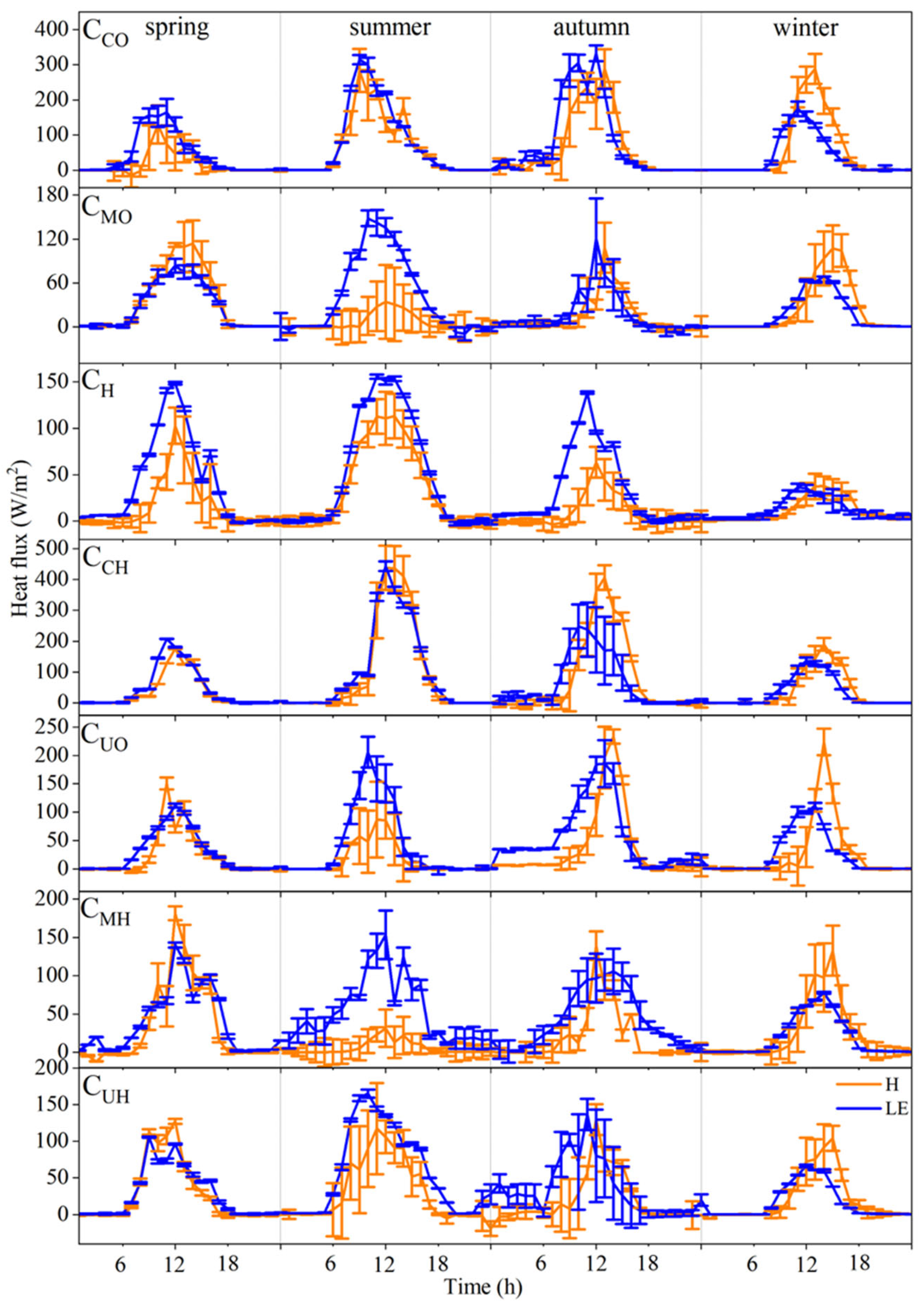
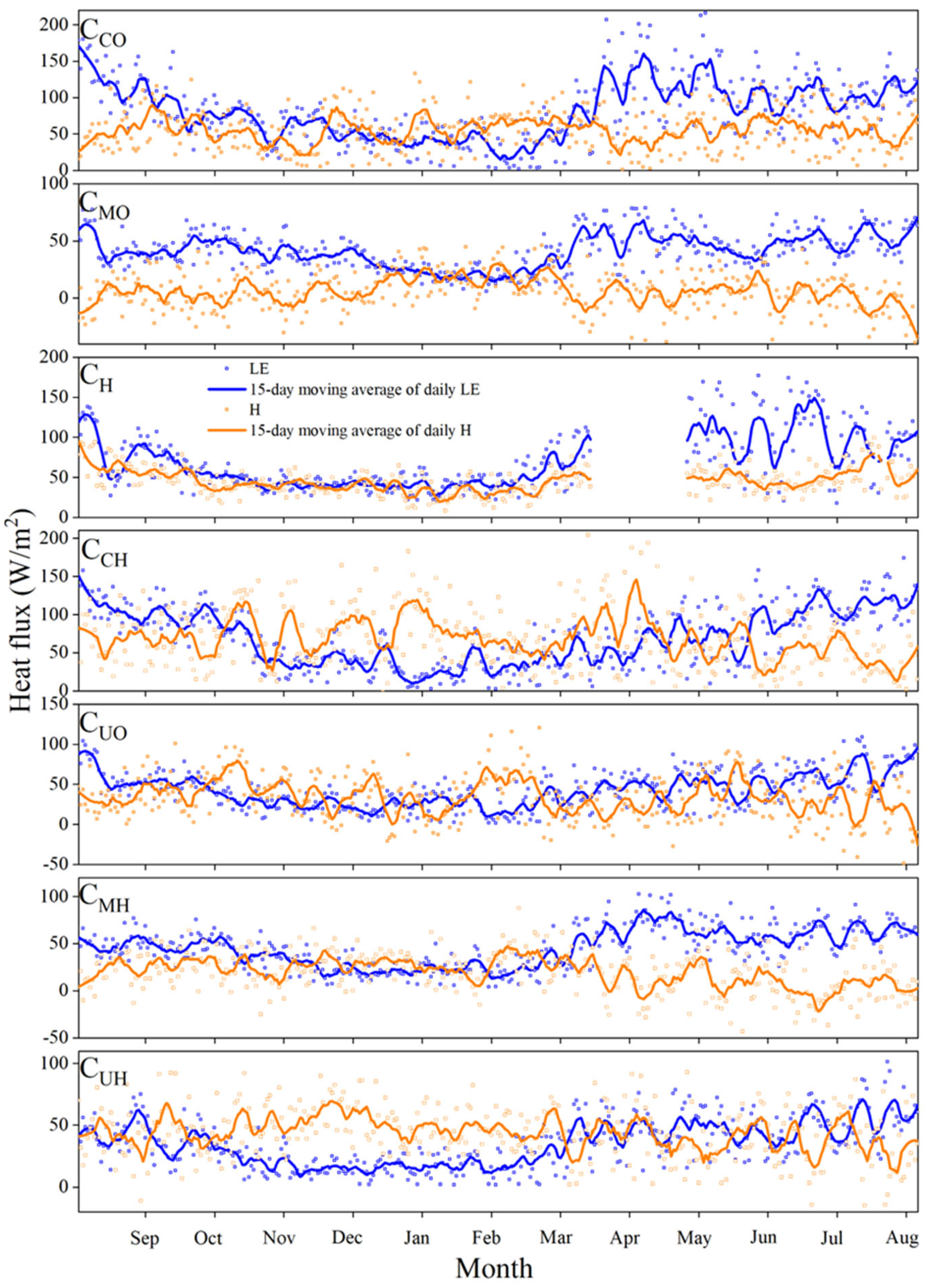
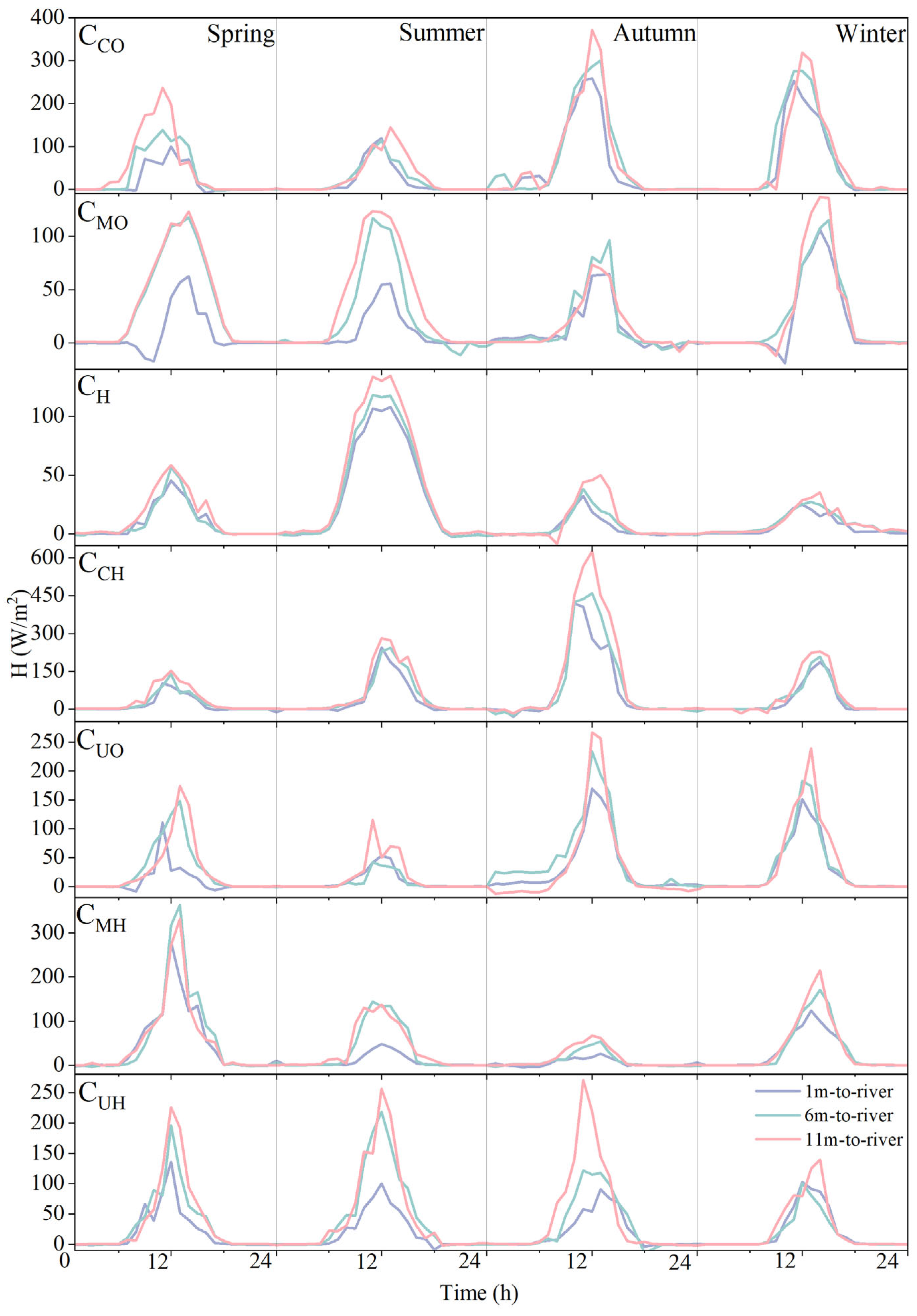

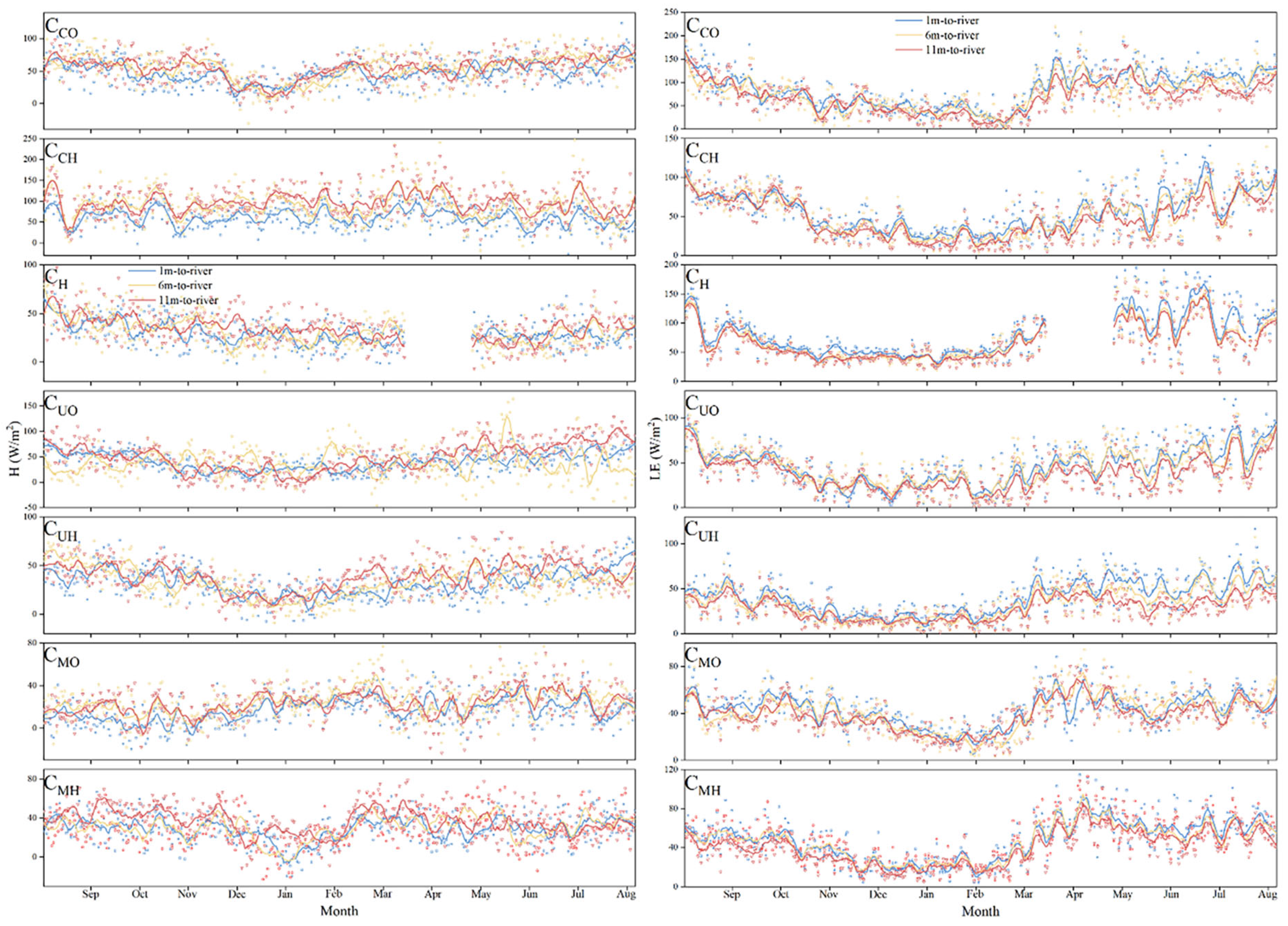
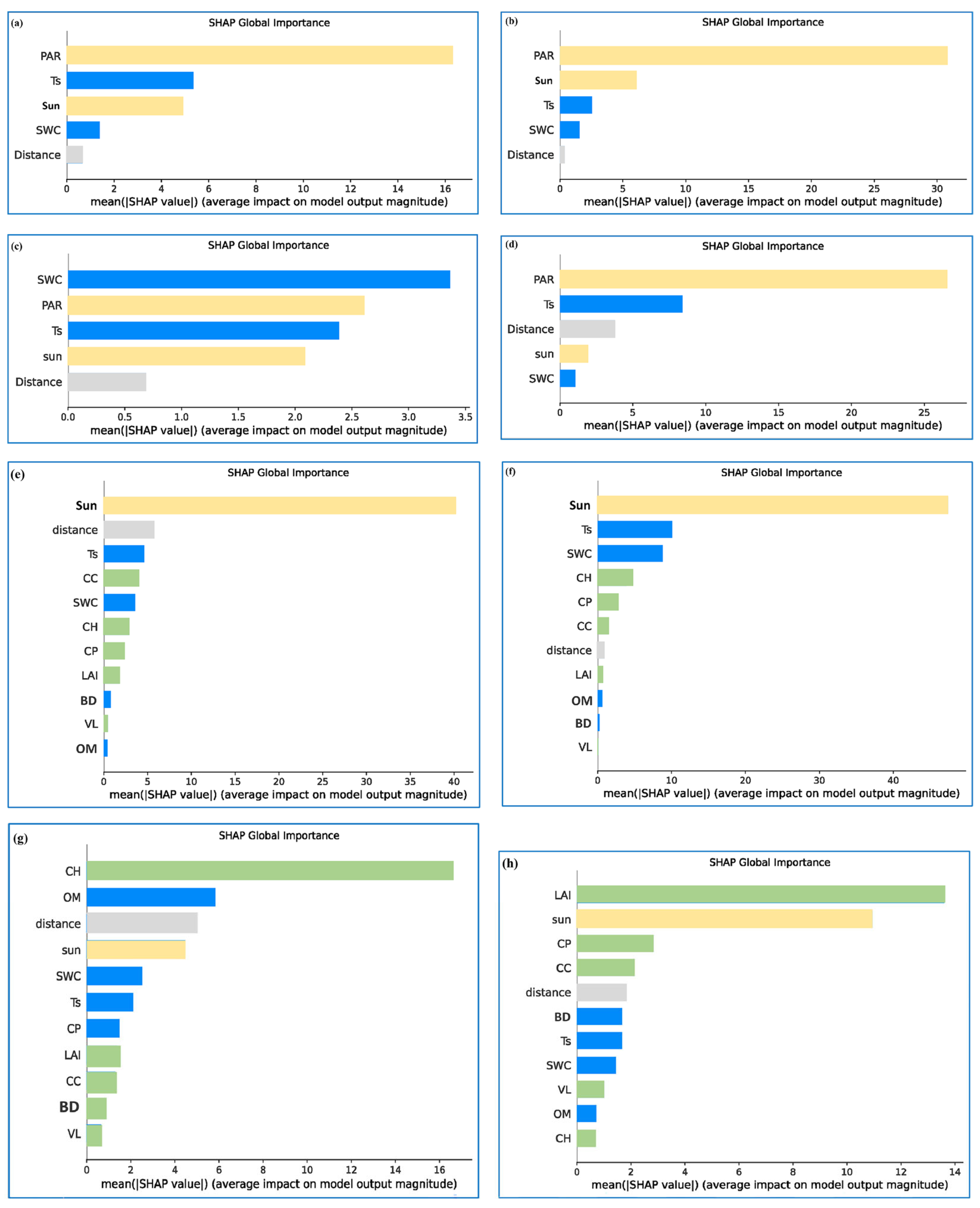
| No. | CCO | CMO | CCH | CUO | CMH | CUH | CH |
|---|---|---|---|---|---|---|---|
| Plant type | Evergreen broadleaf arbor-shrub-grass | Coniferous arbor -shrub-grass | Evergreen broadleaf arbor-grass | Deciduous broadleaf arbor-shrub-grass | Coniferous arbor -grass | Deciduous broadleaf arbor-grass | Grassland |
| Dominant species | Cinnamomum camphora (L.) J. Presl Osmanthus fragrans (Thunb.) Lour. Oxalis corniculate L. | Metasequoia glyptostroboides Hu and W. C. Cheng Osmanthus fragrans (Thunb.) Lour. Ophiopogon japonicus (L. f.) Ker Gawl. | Cinnamomum camphora (L.) J. Presl Osmanthus fragrans (Thunb.) Lour. (Thunb.) Lour. | Ulmus parvifolia Jacq. Osmanthus fragrans (Thunb.) Lour. Ophiopogon japonicus (L. f.) Ker Gawl. | Metasequoia glyptostroboides Hu and W. C. Cheng Zoysia japonica Steud. | Ulmus parvifolia Jacq. Oxalis corniculate L. | Zoysia japonica Steud. Trifolium repens L. |
| Density (/hm2) | 375 | 1050 | 325 | 400 | 850 | 400 | / |
| Height (m) | 9.76 | 12.80 | 9.80 | 9.60 | 13.00 | 9.04 | 0.3 |
| Soil type | Loamy | Loamy | Sandy loam | Sandy loam | Sandy loam | loamy | Sandy loam |
| Soil organic matter (g/kg) | 19.67 | 29.73 | 24.97 | 15.5 | 6.11 | 18.93 | 22.3 |
| Parameters | Unit | Instrument | Model | Accuracy | Height (m) | Distance-to-River (m) |
|---|---|---|---|---|---|---|
| Net radiation | W/m2 | Net radiometer | CNR4, Kipp and Zonen, Delft, The Netherlands | ±5% | 10/12 | 6 |
| Sunshine duration | h | Sunshine duration sensor | CSD3, Kipp and Zonen, Delft, The Netherlands | ±3% | 10/12 | 6 |
| Photosynthetically active radiation | μmol/m2/s | Photosynthetically active radiation sensor | PQS1, Kipp and Zonen, Delft, The Netherlands | ±5% | 10/12 | 6 |
| Wind speed | m/s | Wind speed sensor | JXBS-3001, JXCT, Weihai, China | ±1 m/s | 0.5, 4, 10/12 | 1, 6, 11 |
| Air temperature | ℃ | Air temperature and humidity sensor | RS-BYQXZ-M-1, Renke Control Technology, Jinan, China | 0.1 °C | 0.5, 4, 10/12 | 1, 6, 11 |
| Relative humidity | % | RS-BYQXZ-M-1, Renke Control Technology, Jinan, China | 0.1% | 0.5, 4, 10/12 | 1, 6, 11 | |
| Soil water content | % | Soil temperature and humidity probes | RS-WS-N01-TR, Renke Control Technology, Jinan, China | ±2% | −0.03 | 1, 6, 11 |
| Soil temperature | ℃ | RS-WS-N01-TR, Renke Control Technology, Jinan, China | 0.5 °C | −0.03 | 1, 6, 11 |
Disclaimer/Publisher’s Note: The statements, opinions and data contained in all publications are solely those of the individual author(s) and contributor(s) and not of MDPI and/or the editor(s). MDPI and/or the editor(s) disclaim responsibility for any injury to people or property resulting from any ideas, methods, instructions or products referred to in the content. |
© 2025 by the authors. Licensee MDPI, Basel, Switzerland. This article is an open access article distributed under the terms and conditions of the Creative Commons Attribution (CC BY) license (https://creativecommons.org/licenses/by/4.0/).
Share and Cite
Qin, Y.; Yang, C.; Liang, A.; Xie, C.; Zhang, Y.; Wang, J.; Che, S. Temporal and Spatial Variations of Energy Exchanging Under Varying Urban Riparian Forest Plant Communities: A Case Study of Shanghai, China. Forests 2025, 16, 1466. https://doi.org/10.3390/f16091466
Qin Y, Yang C, Liang A, Xie C, Zhang Y, Wang J, Che S. Temporal and Spatial Variations of Energy Exchanging Under Varying Urban Riparian Forest Plant Communities: A Case Study of Shanghai, China. Forests. 2025; 16(9):1466. https://doi.org/10.3390/f16091466
Chicago/Turabian StyleQin, Yifeng, Caihua Yang, Anze Liang, Changkun Xie, Yajun Zhang, Jing Wang, and Shengquan Che. 2025. "Temporal and Spatial Variations of Energy Exchanging Under Varying Urban Riparian Forest Plant Communities: A Case Study of Shanghai, China" Forests 16, no. 9: 1466. https://doi.org/10.3390/f16091466
APA StyleQin, Y., Yang, C., Liang, A., Xie, C., Zhang, Y., Wang, J., & Che, S. (2025). Temporal and Spatial Variations of Energy Exchanging Under Varying Urban Riparian Forest Plant Communities: A Case Study of Shanghai, China. Forests, 16(9), 1466. https://doi.org/10.3390/f16091466








